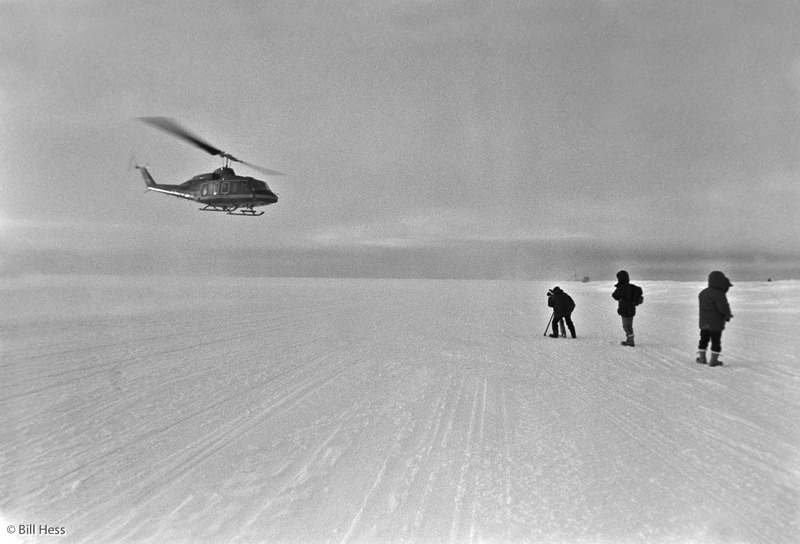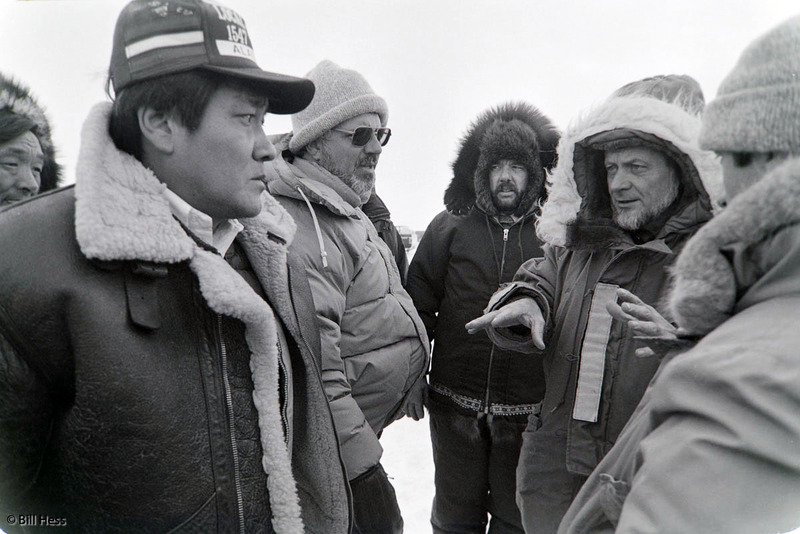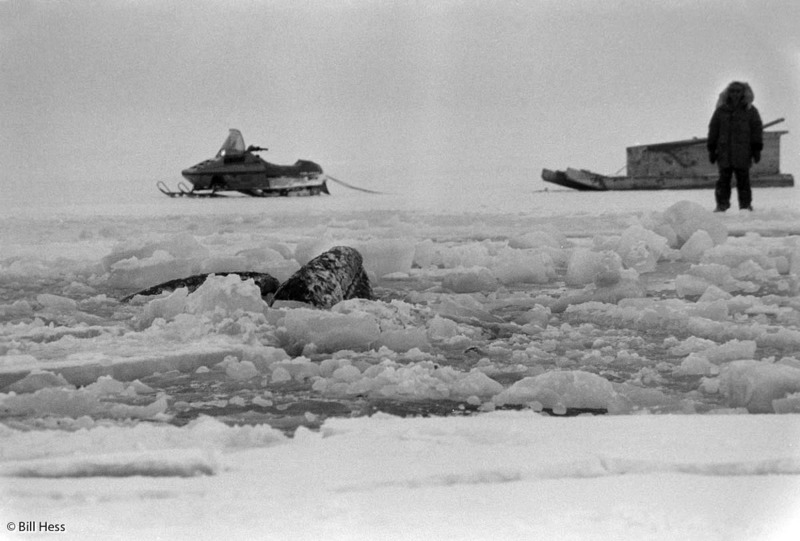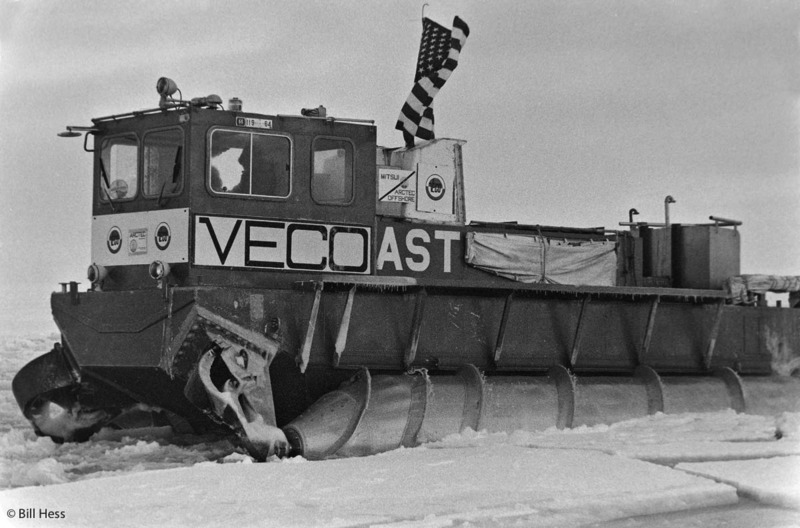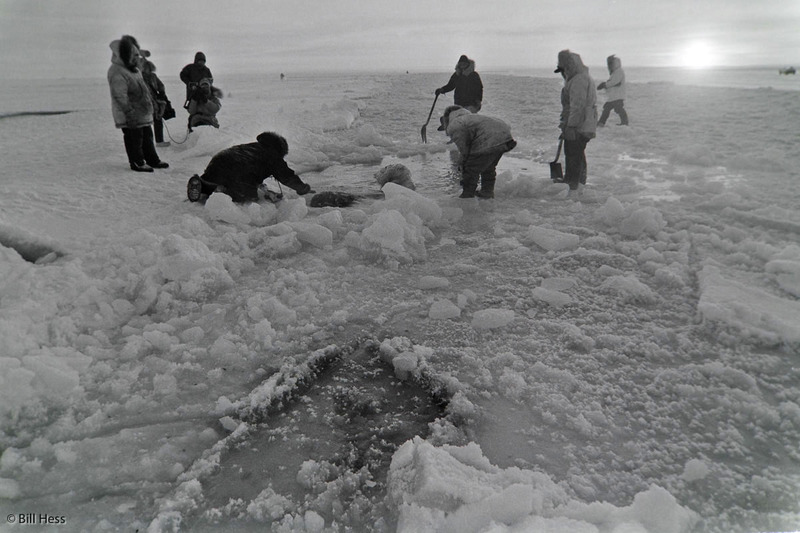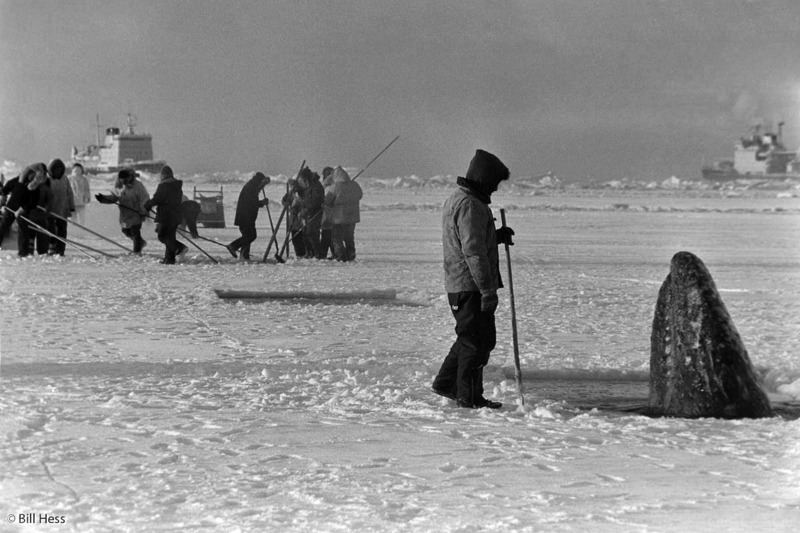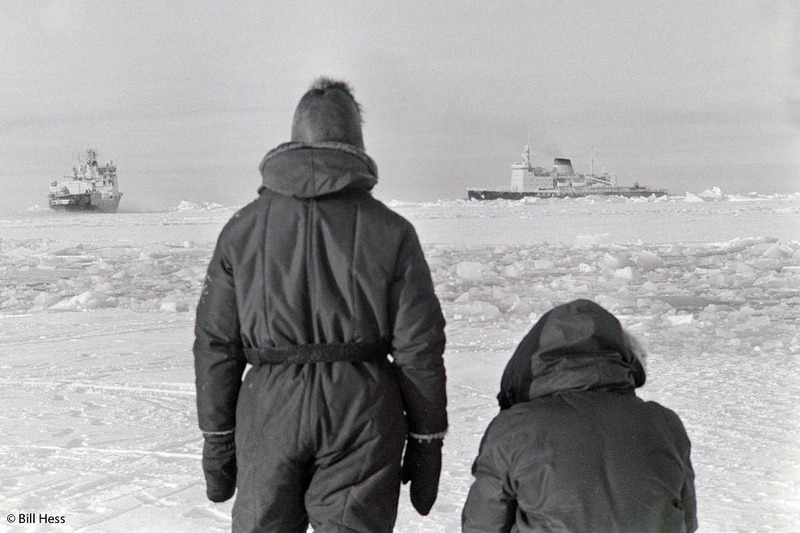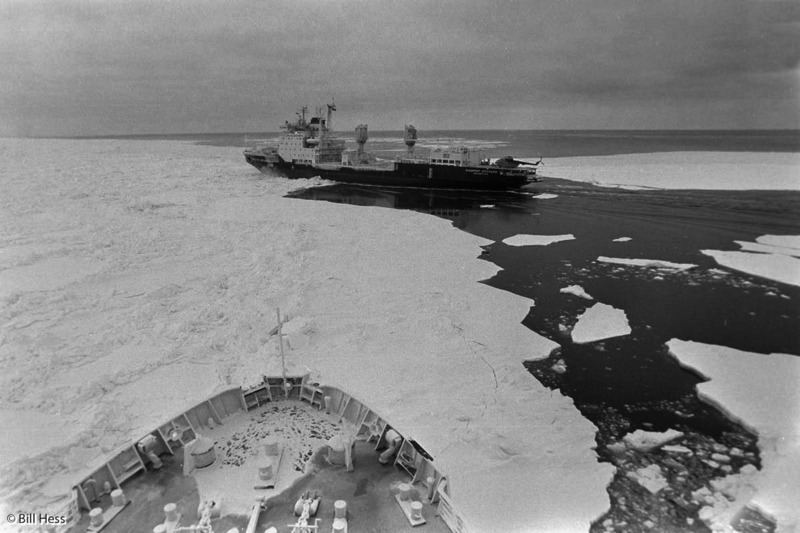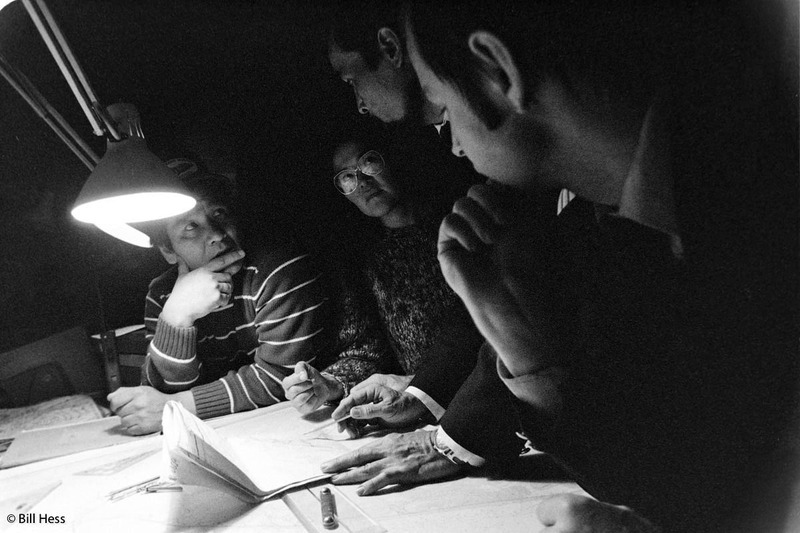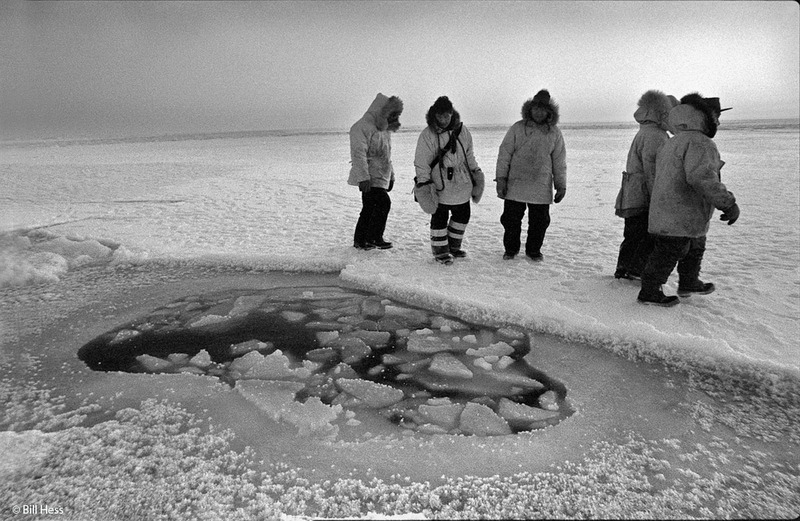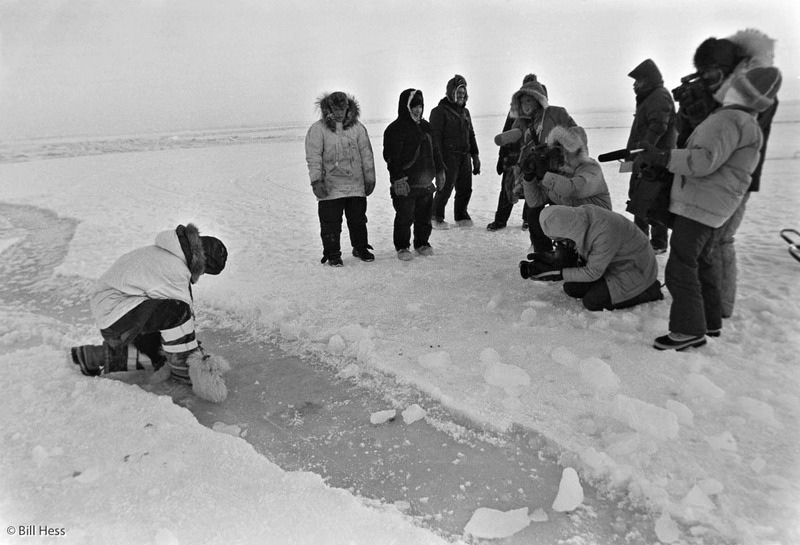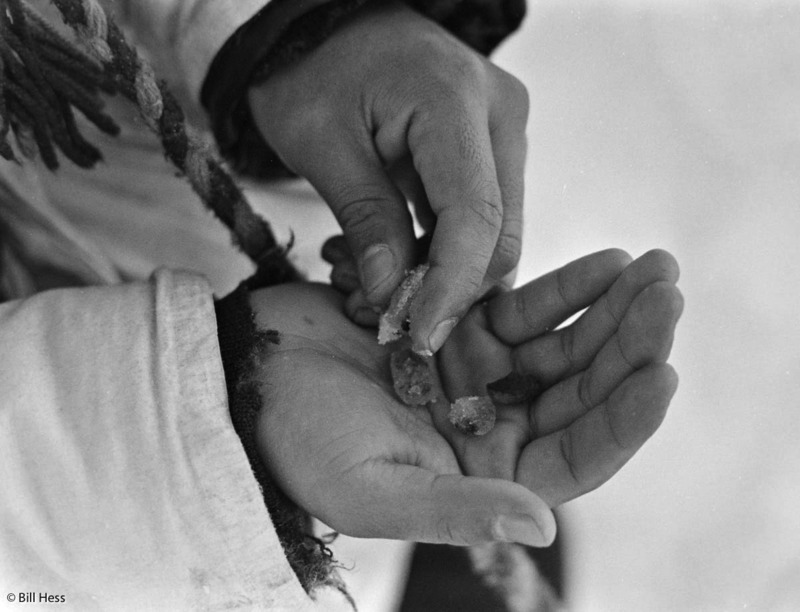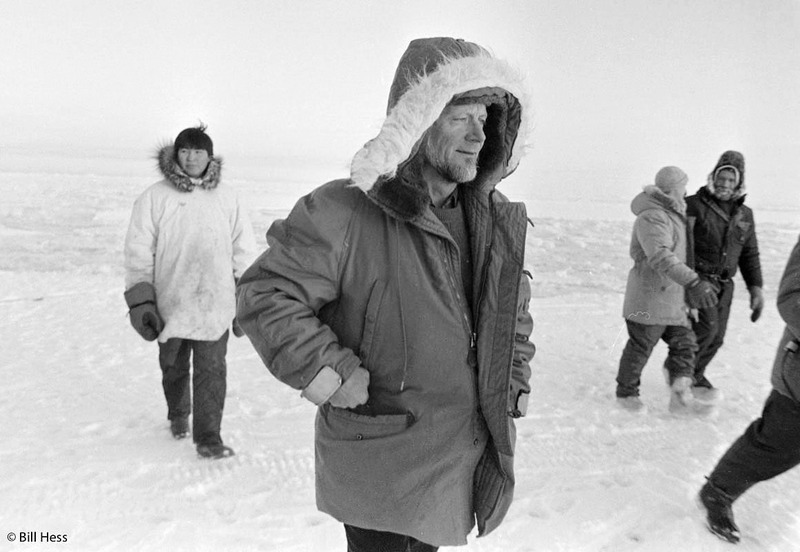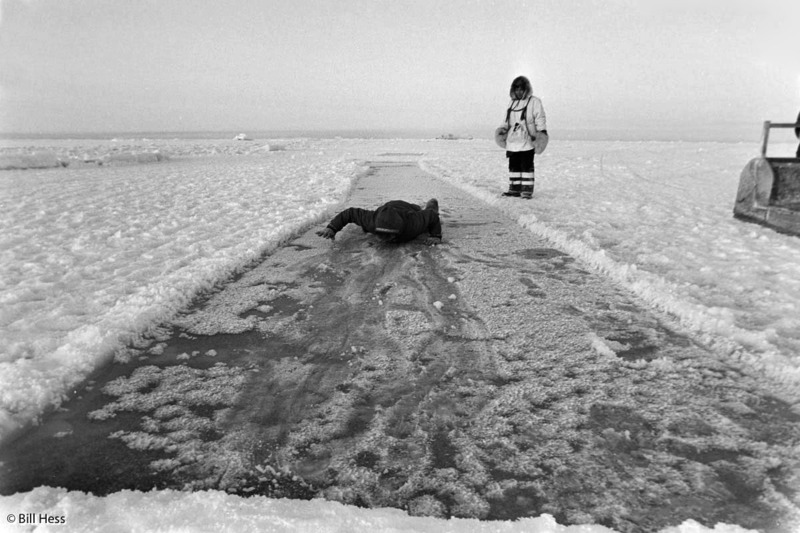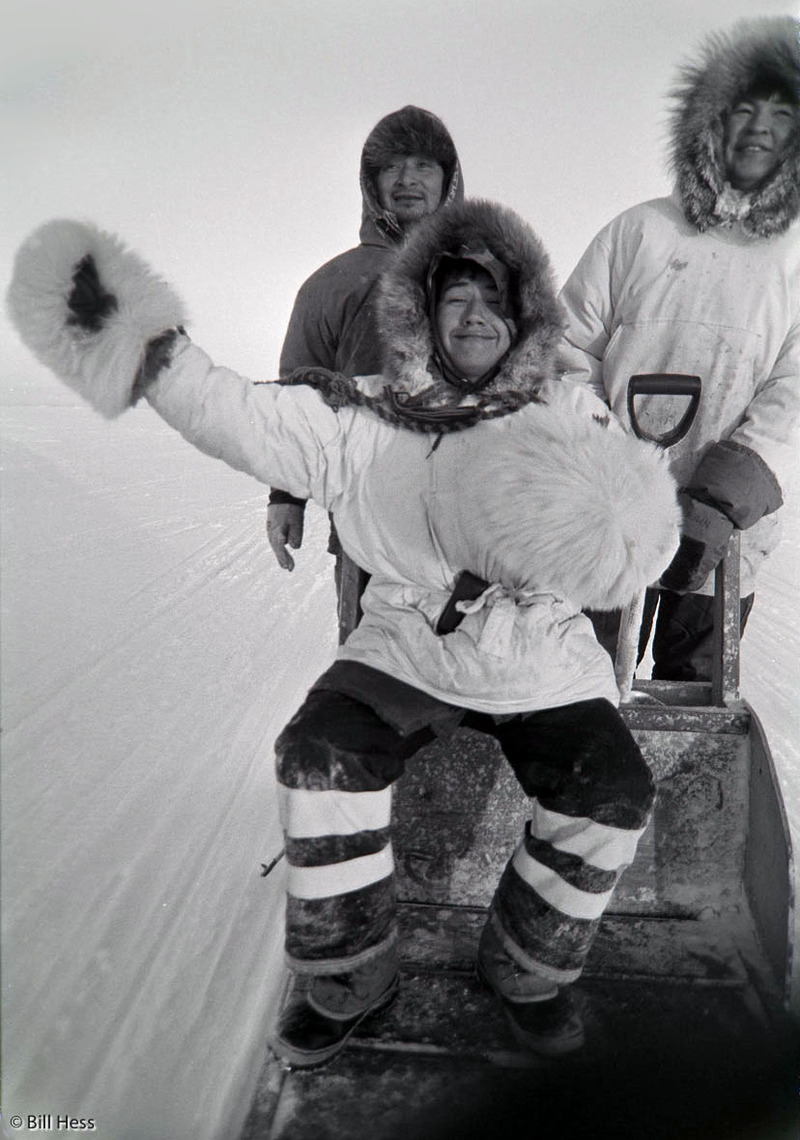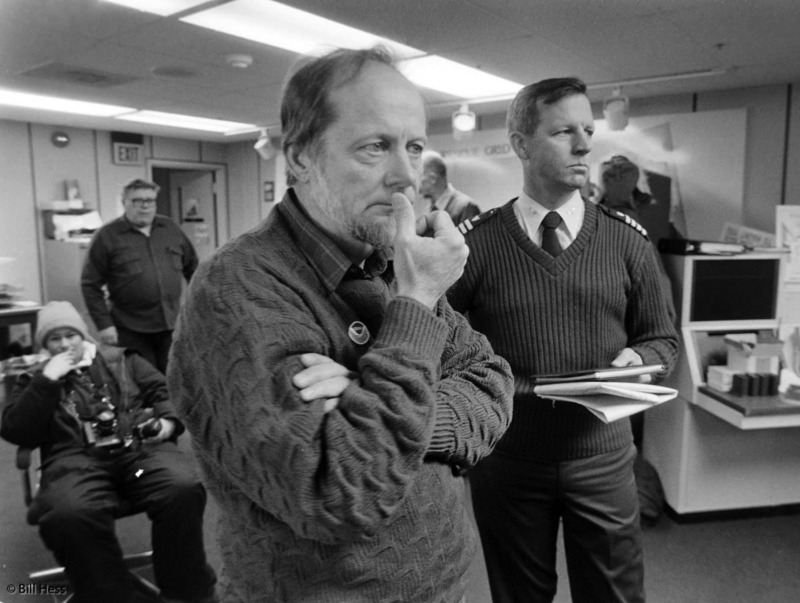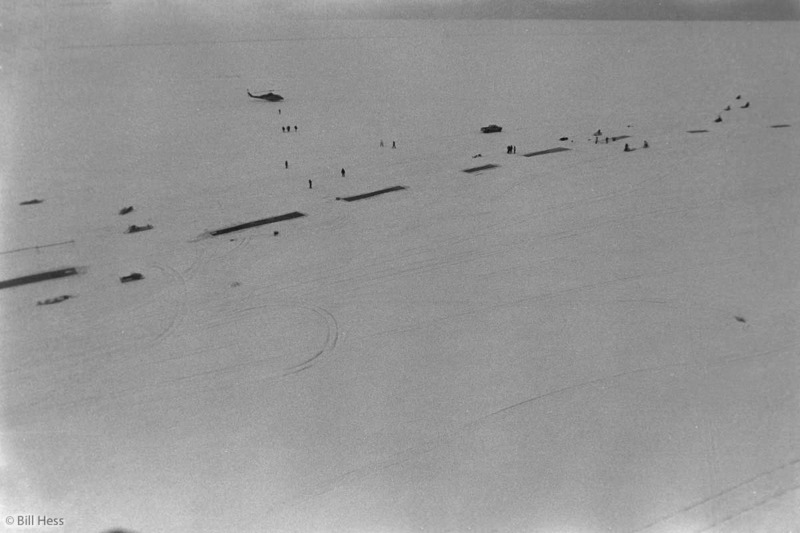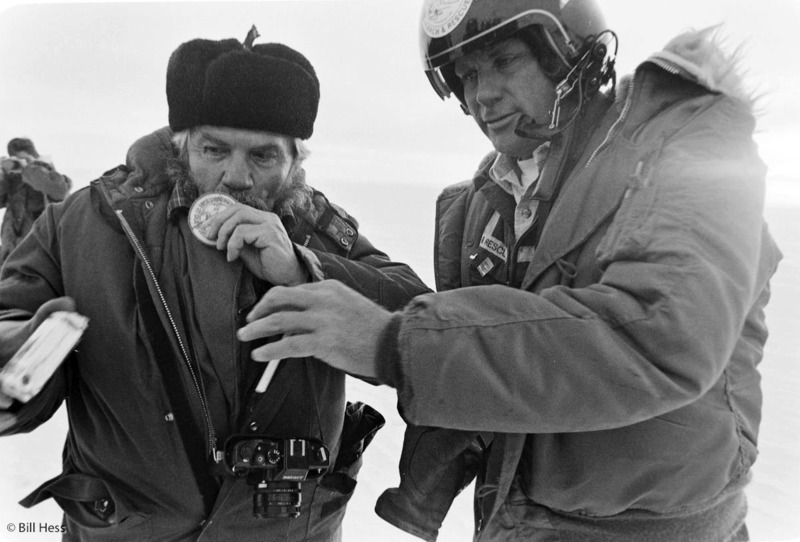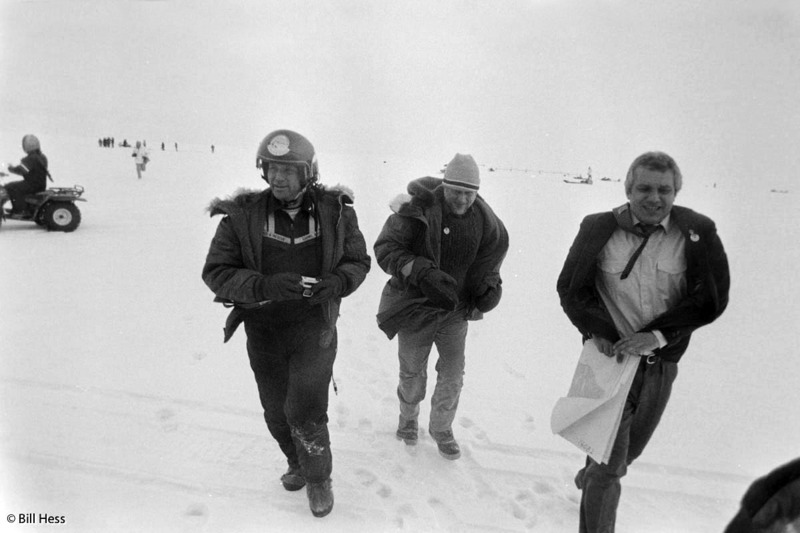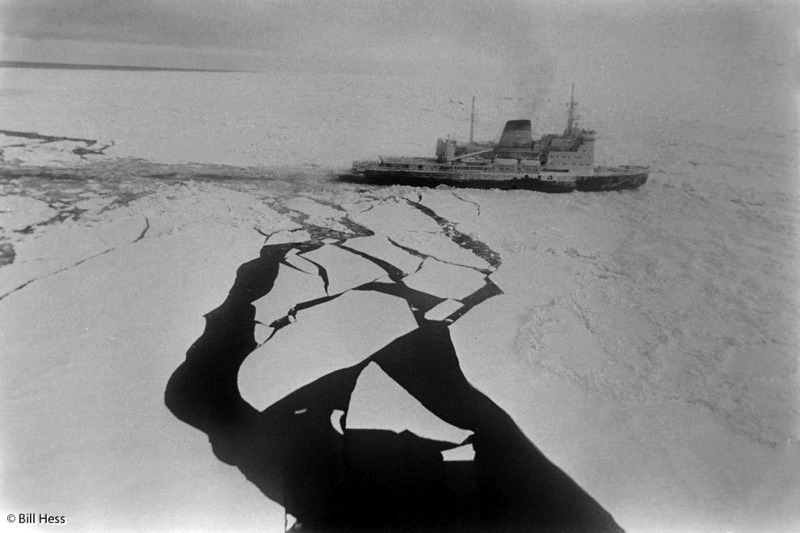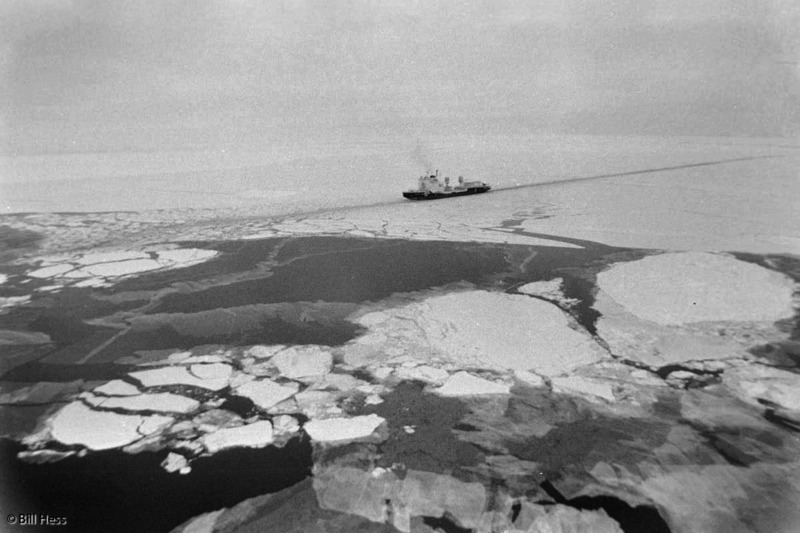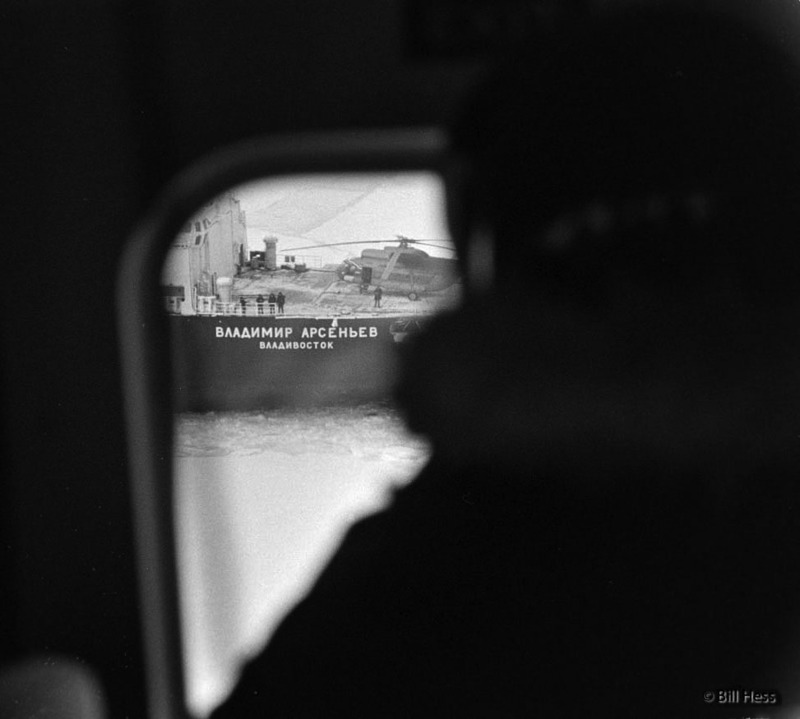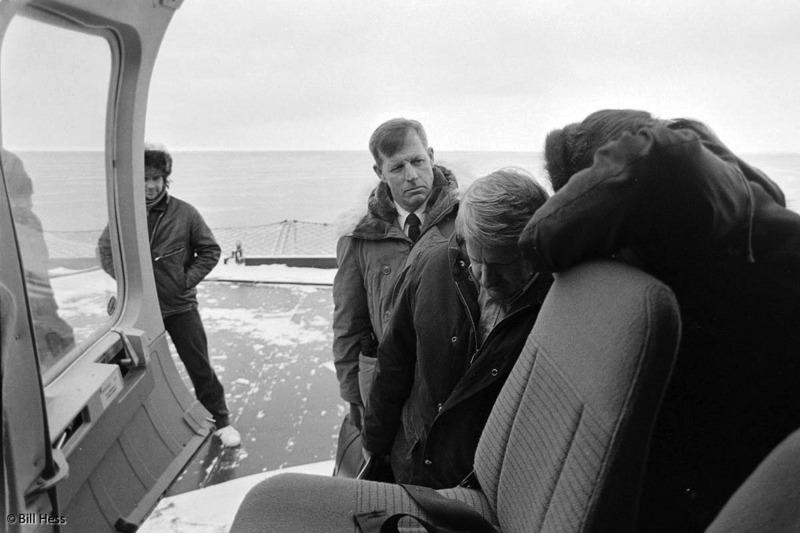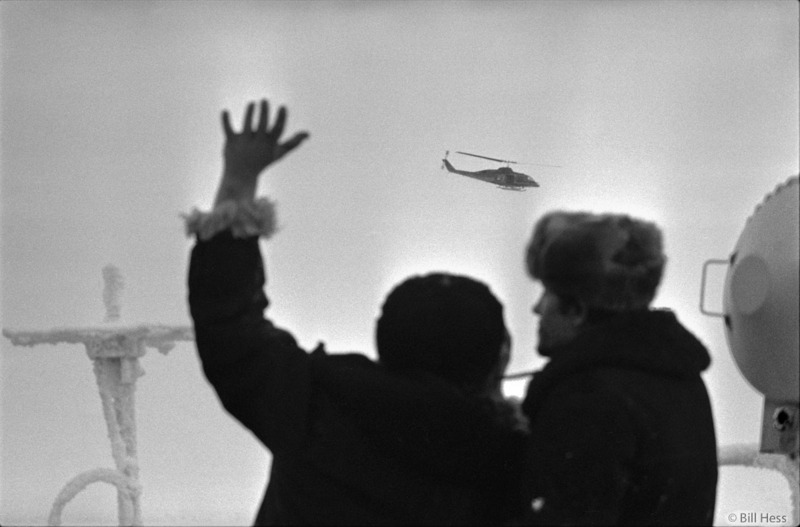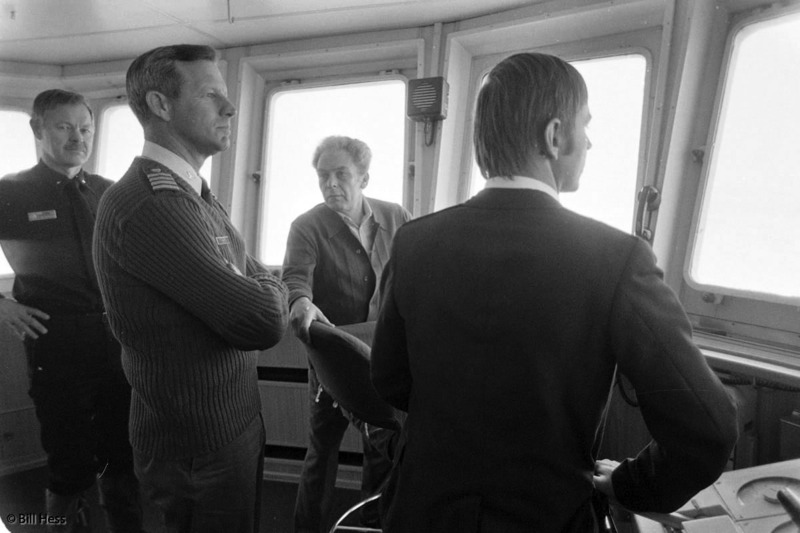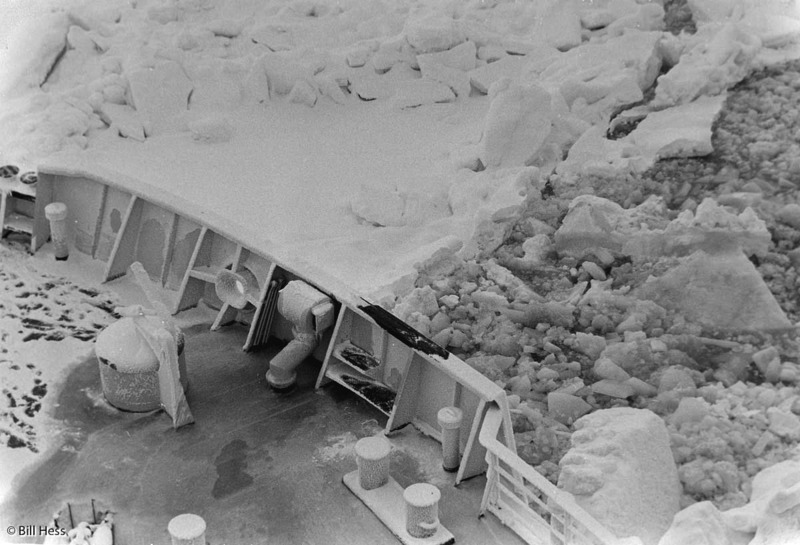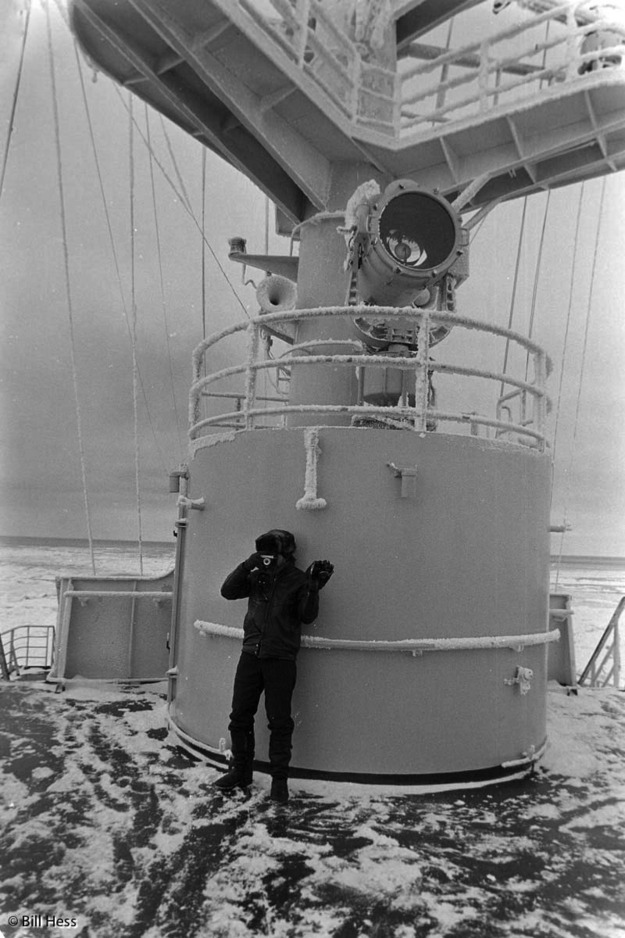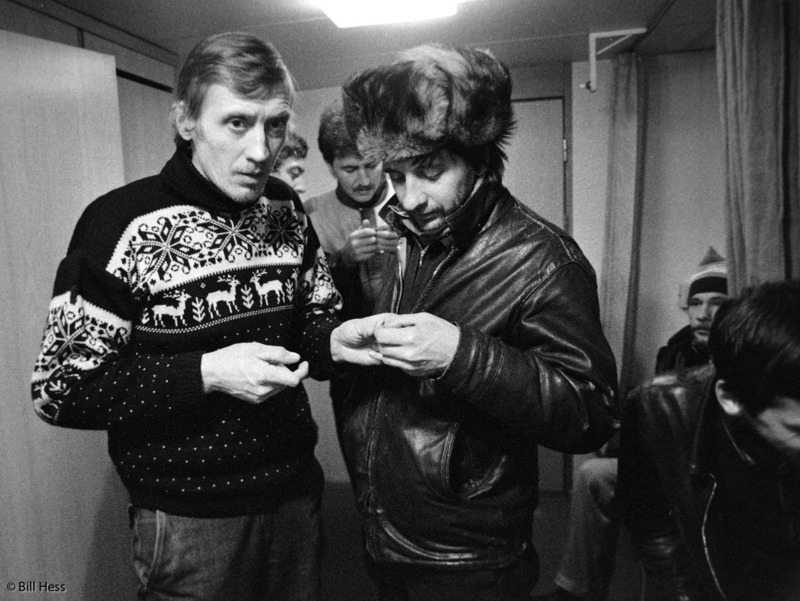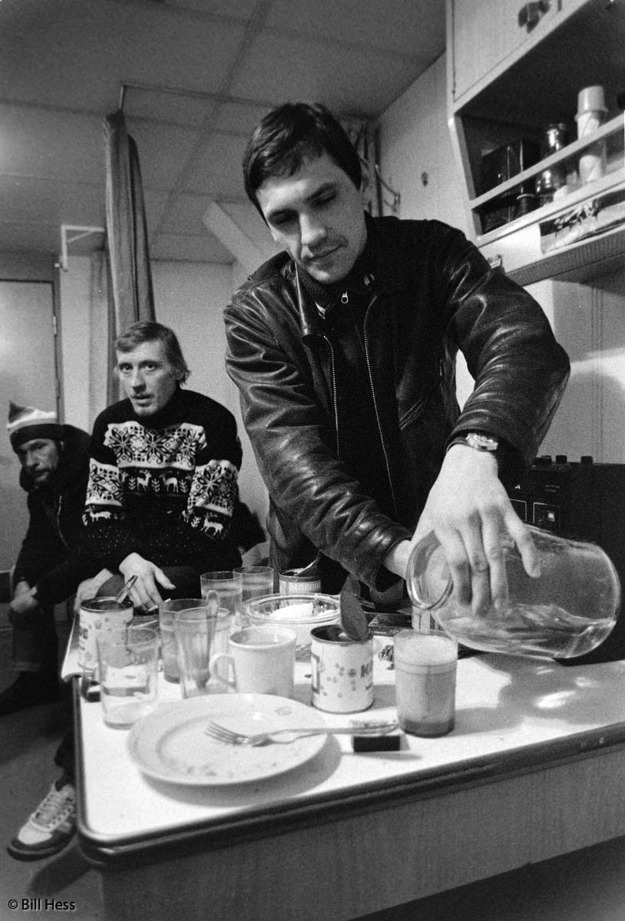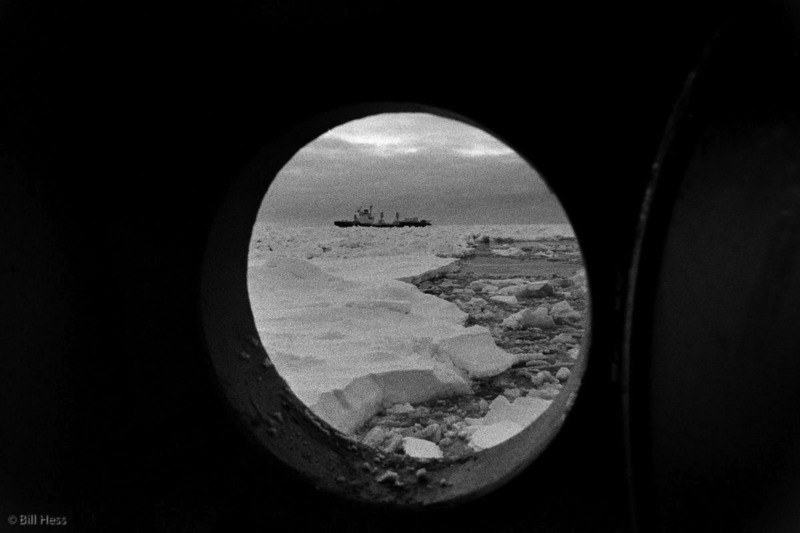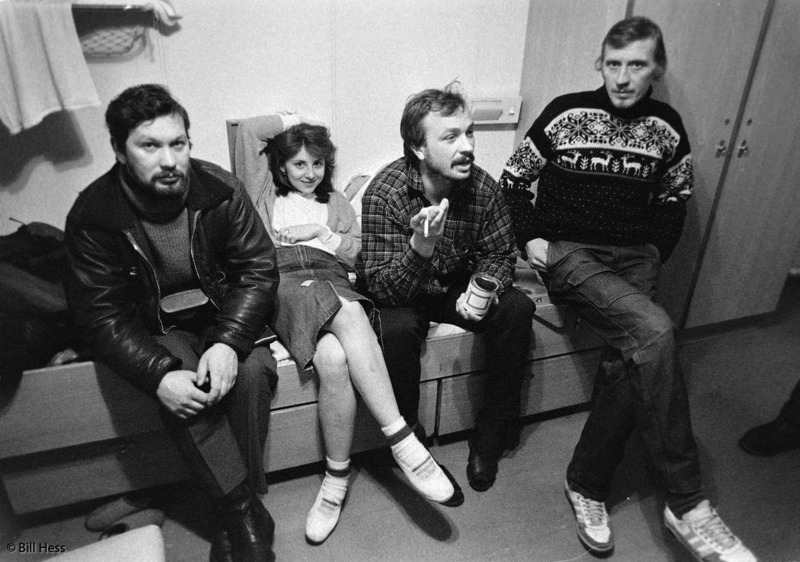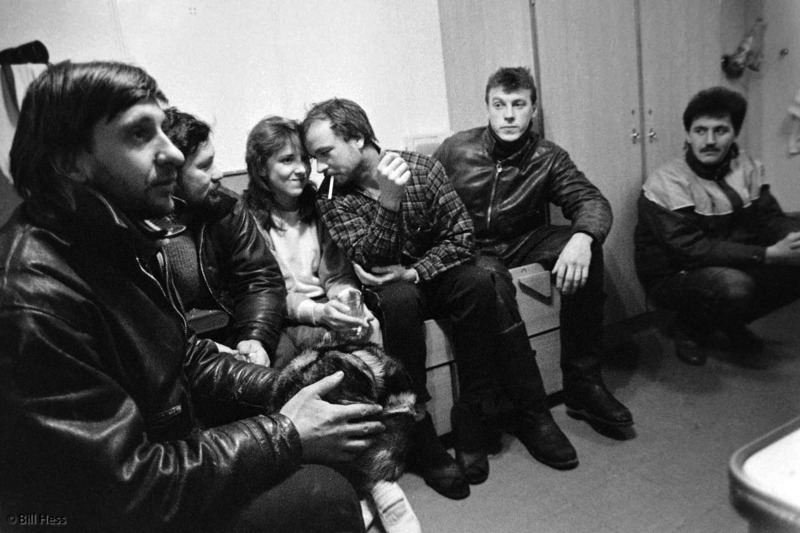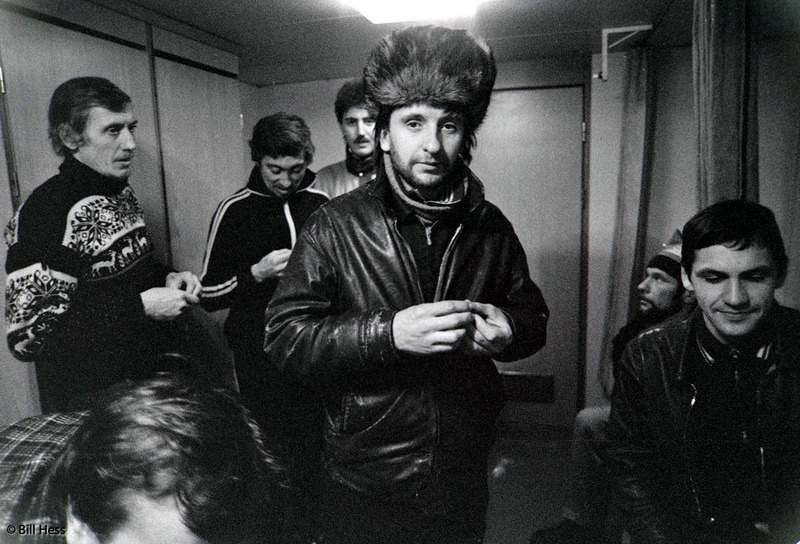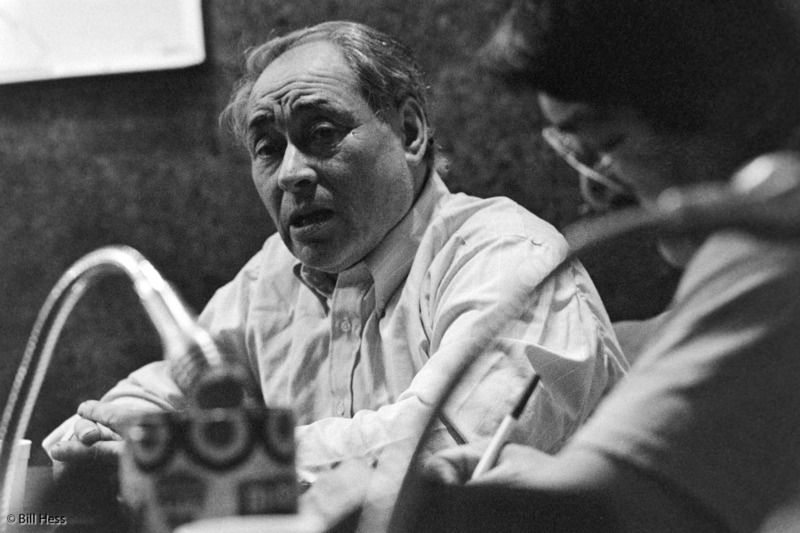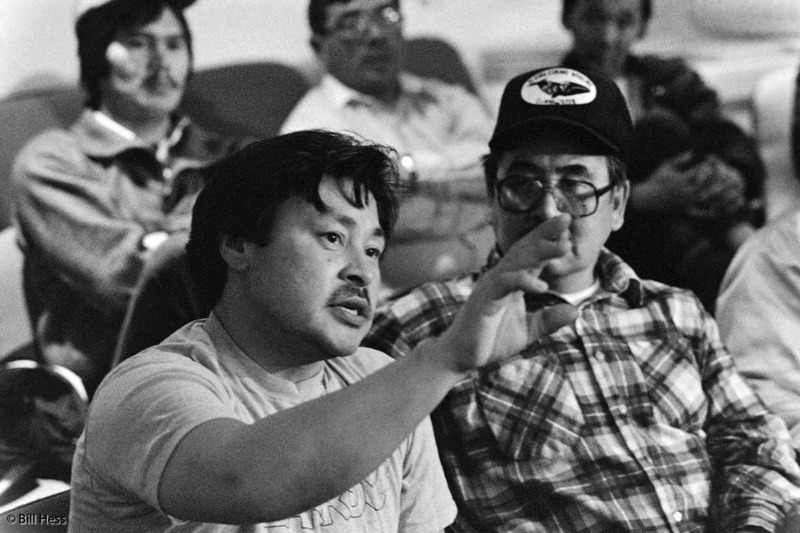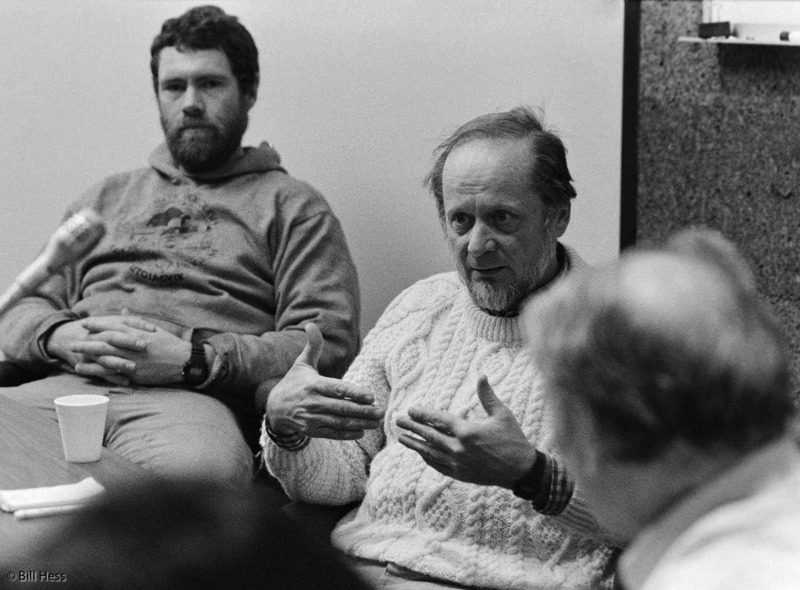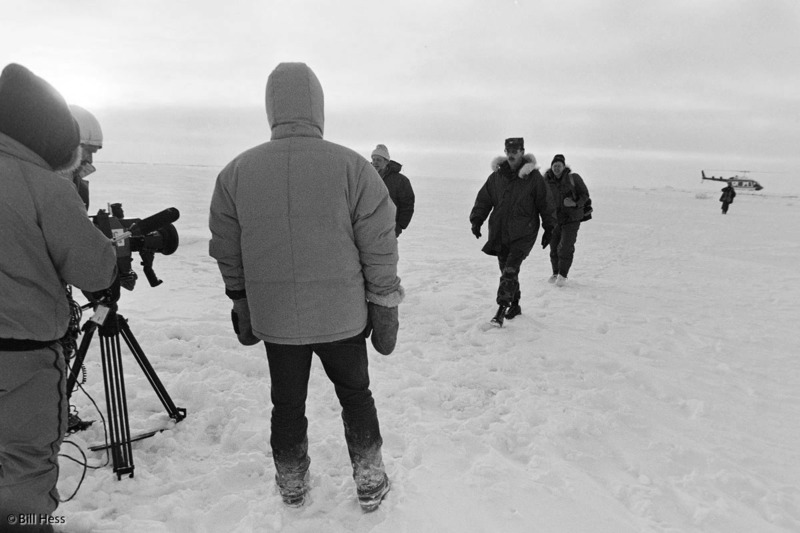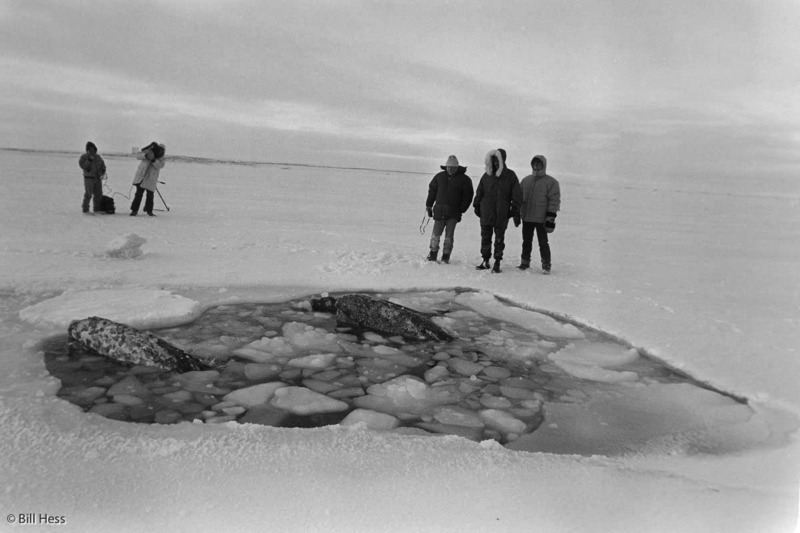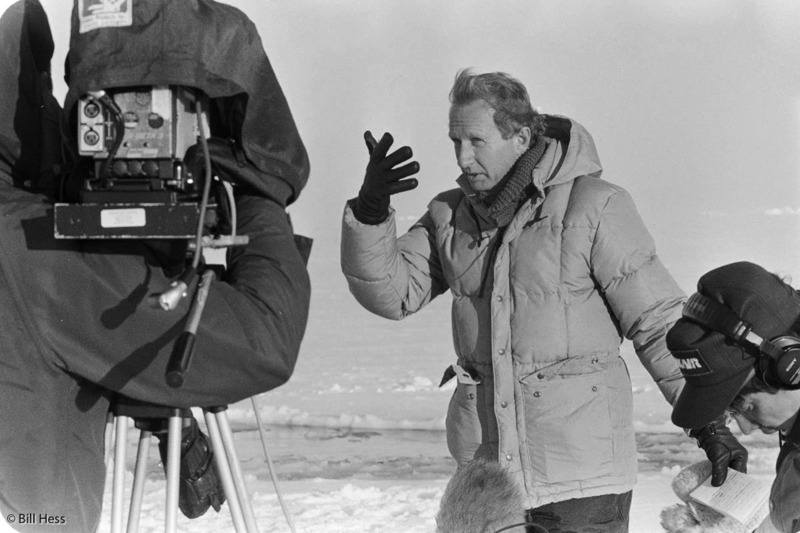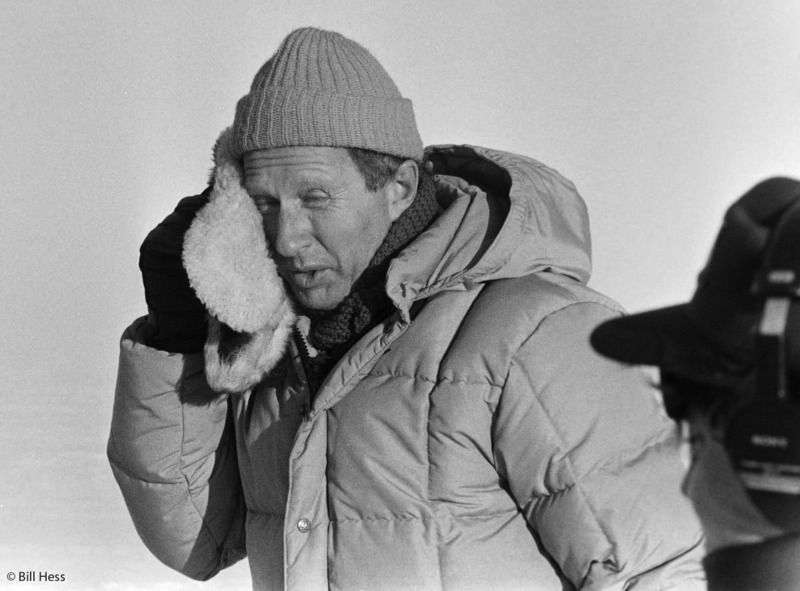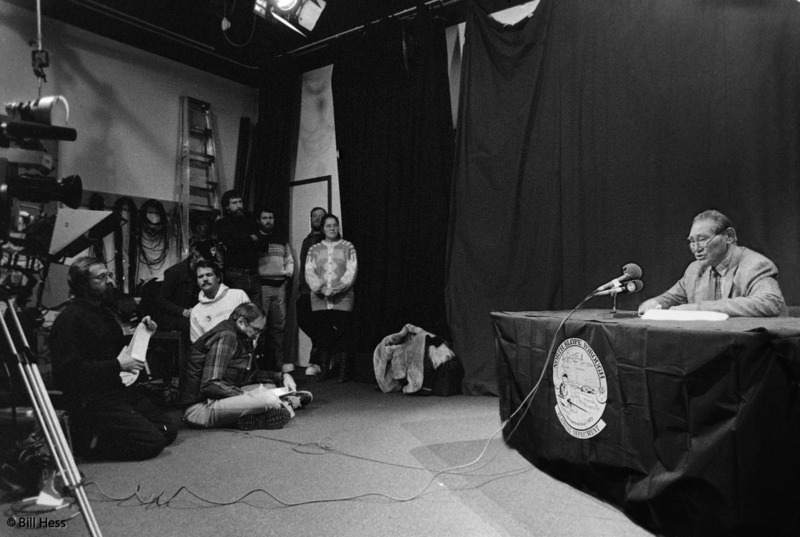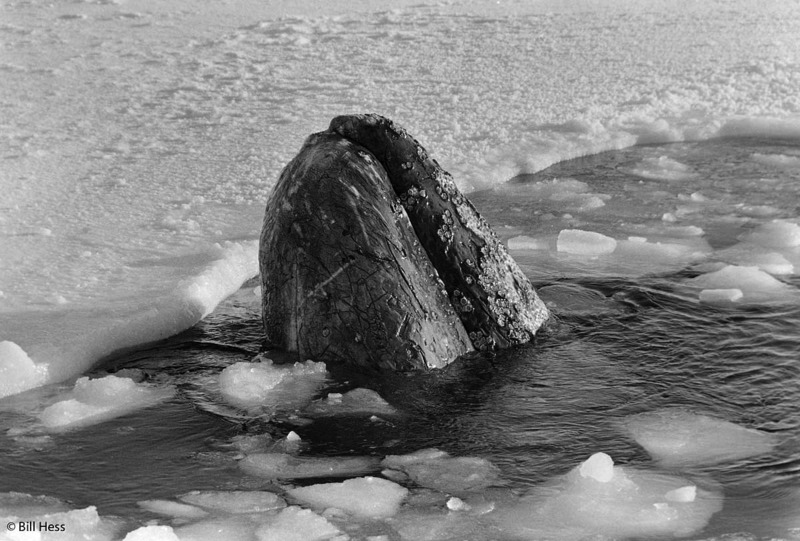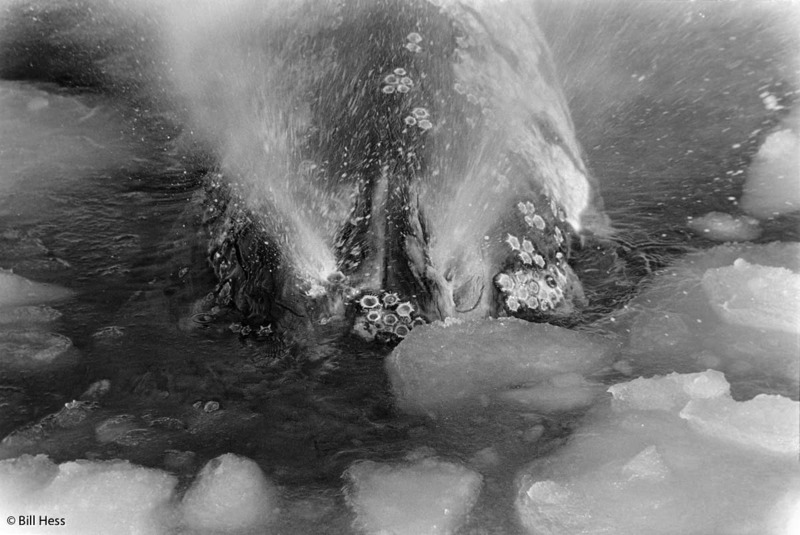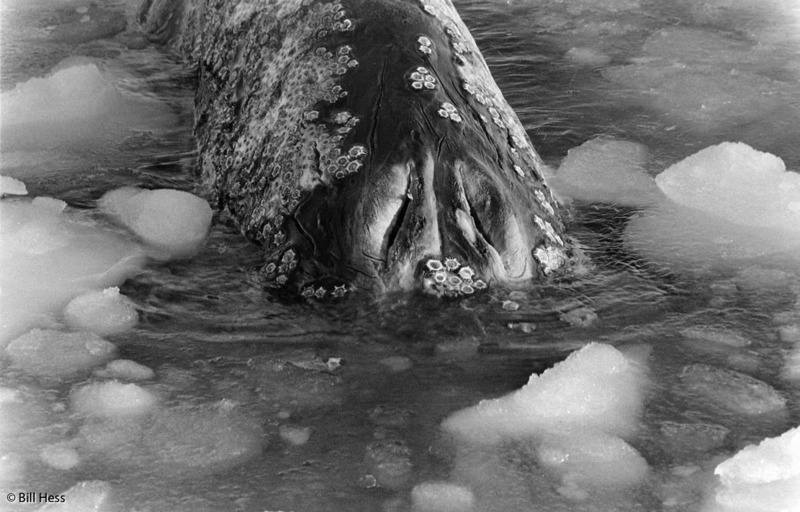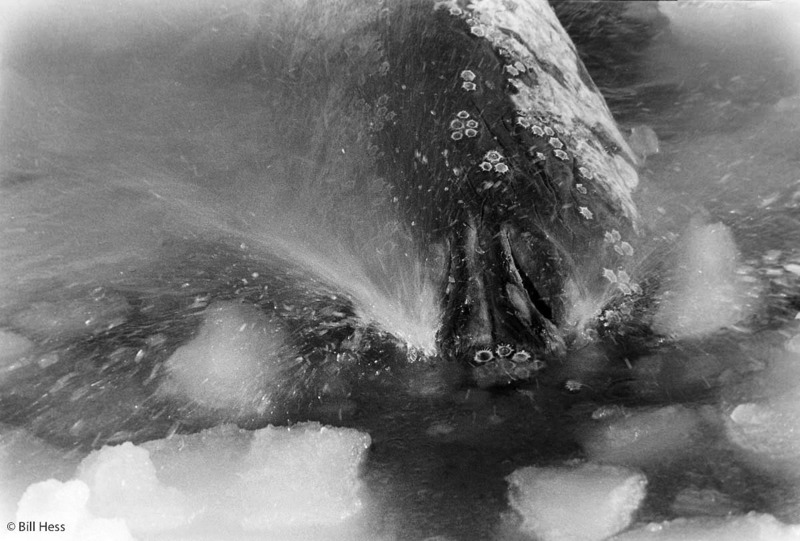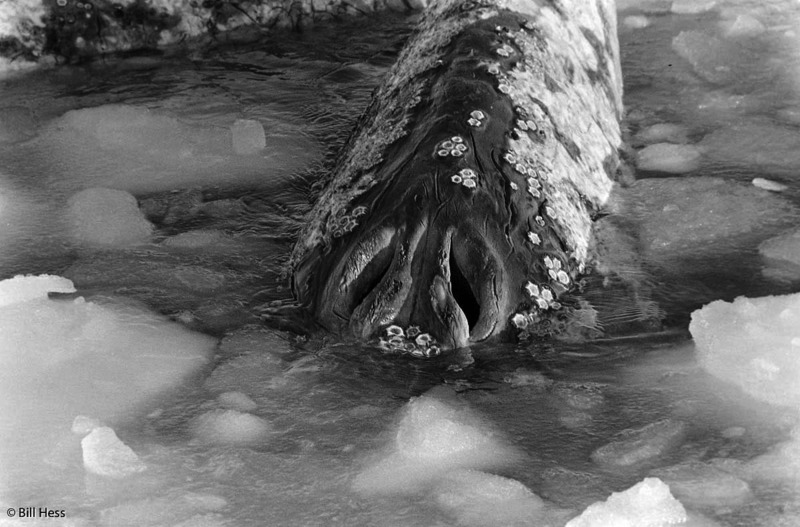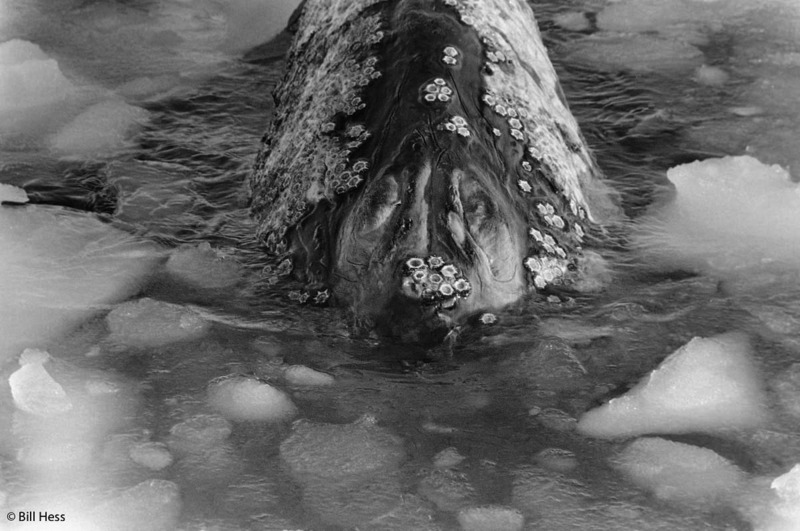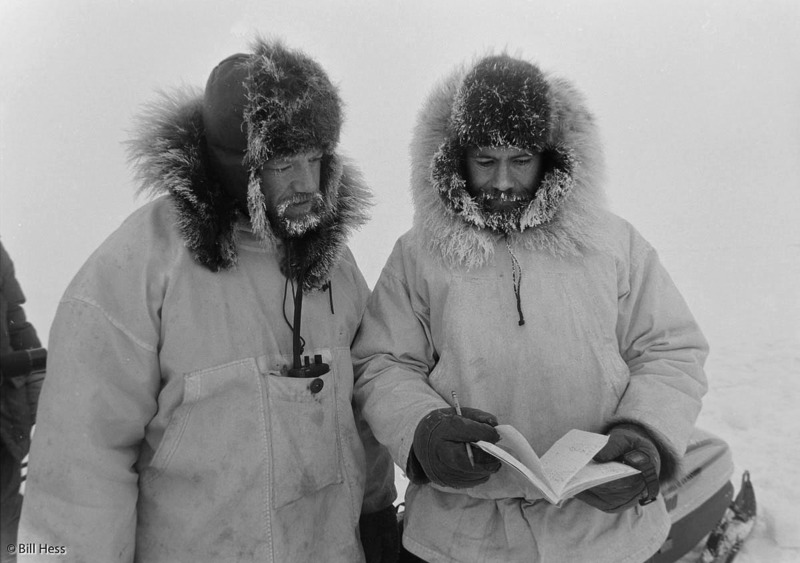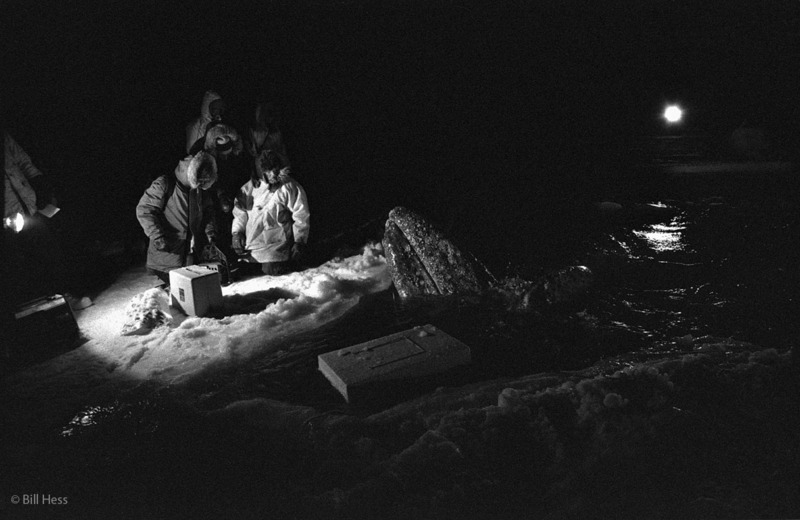The movie Big Miracle and what I witnessed in real life, part 14: icebreakers, false news reports, helicopters, whales, biologists; who knows? Men walk and crawl like polar bears
 Saturday, February 25, 2012 at 1:55PM
Saturday, February 25, 2012 at 1:55PM The story gets kind of complex here, but I am in Arizona, soon to leave for India, am flat out of time and so I will attempt to leave a whole bunch of stuff out and try to tell it quickly:*
Logic told me the only good place to photograph the Soviet icebreakers as they cut down the pressure ridge and opened up a path for the whales would be from a helicopter. As I have explained, to be anywhere on the ice near the whales once the icebreakers moved in would be to risk one's life.
Once the light fog that had surrounded Malik and whales at the time of goodbye lifted, the icebreakers could be seen from shore, but not the whales. The distance was about four miles, which put the view of the whales as they surfaced in the chainsaw holes below the curvature of the earth - plus, if I had been able to see them from that distance, at most, even with my longest telephoto lens, they would have appeared only as tiny dots.
I knew that Ron Morris would not knowingly let me on any helicopter that he had any say over, but I talked to Steve Cox, who would be piloting the Long Ranger. He gave me a radio, told me to call when I felt the moment was right and he would swoop down and pick me up.
When the moment was right, I called. No response. I called again. No response. A few minutes later, I tried again. No response.
Then I learned that Morris had commandeered the Long Ranger to be his personal aircraft for the remainder of the rescue. That left the Big Bird, but Morris had drawn up a list of media who could fly in it for this event and I was not on it. In fact, no photographer was. Morris chose national TV, AP reporter Bruce Bartley and print reporter Rich Mauer, who had arrived late but was now reporting not only for the Anchorage Daily News but the New York Times. NBC had their own helicopter. Mauer is a fine reporter, much more skilled than I, but still it seemed to me that his seat could have been put to much better use by a photographer - myself in particular.
A few media folk tried to venture out onto the ice on their own, but the Big Bird swept down and pushed them back to shore - not to keep them from getting their coverage, but to keep them from getting killed.
The approach of the icebreaker wound up going into delay mode, because what I did not know was that a good number of people had snowmachined out to the ridges from Barrow to welcome the Soviets. They had gone with smiles and Soviet flags and had come close enough to the apparently anchored ships to shout out greetings. I heard that gifts were thrown from the ship to the people on the ice - they were that close. And maybe some gifts were thrown upward, too. It is hard to envision many such throws succeeding, but that is what I heard and I believe it.
The breakers could not advance until the people left the ice - hence the delay. In the meantime, Morris made a couple of landings onshore, the two NOAA biologists who served as his advisers with him. On one landing, Mayor Ahmaogak, left, brought up a number of concerns that he had to Morris, and he did suggest that he find a place for me in one of the helicopters that he had now asserted control over.
Morris, of course, refused.
As it happened, some traffic cones and other gear had been left out on the ice, near one of the whale holes. Geoff Carroll, who is as savvy on the ice as any non-Iñupiaq, maybe just about anyone, set out with a snowmachine and sled to retrieve the gear. I hopped on with him.
When he stopped, I stood up on the snowmachine seat behind him with a 300 mm telephoto lens. To my amazement, from the vantage of just that extra couple of feet, I could see a line of holes, the whales when they surfaced and the icebreakers coming - one of them had already penetrated the pressure ridges and was coming straight for the whales. Very soon, they would demolish the very ice which we now occupied, but not before I could snap this frame the holes, the whales, and the icebreakers while Geoff loaded the cones and gear into the sled.
Then we were out of there, racing back to land.
Then, from the shore, too far away to distinguish any discernable action, I watched, helpless, as the icebreakers ripped their way through the ice toward the whales. Finally, we got word the job was done - channels had been opened up all the way from the lead to the whales. The whales were now swimming in the channels, toward the lead. I cannot remember precisely how long... an hour, two, three... but a quiet period was designated in which no one was to go out on the ice to approach the whales. We were to let them be, let them move out on their own. This all made good sense.
The temperature was about -17 or -18 F, (-27 C). Whaling captain Roy Nageak had driven his truck and family out to watch and invited me to come in and warm up with them. I had not thought I was cold, but even now I can feel how wonderful the heat generated by his idling engine felt. Roy had his car radio on, tuned to KBRW. Soon, the hourly news came on. The lead story was from AP - the gray whales had been rescued, it said, quoting Ron Morris, by the Soviet icebreakers and were swimming free - they were on their way to the sun, warmth and Beach Boy music of Southern California.
But they weren't.
The whales - who I doubt cared anything at all about Beach Boy music, had not yet been rescued, they were not going south, they were not in the lead, but were were still here, trapped in the ice - although many in the media, believing the story to be over, were already at the airport waiting to board the evening flight out. Many left.
The icebreaker channel the whales swam in had quickly filled with chunks and slush, which soon began to harden into rubble ice, leaving a few pools here and there. The two whales had made some forward progress, but then they had begun to cut and slash themselves on the hardened slush and jagged chunks, so they stopped and took refuge in one large pool.
As the situation became clear, Bill Allen jumped back into action with the Archimedean Screw Tractor, flying the American flag in front of the Soviet Icebreakers. Apparently, he thought he could clear the icebreaker channels of slush and ice chunks, even though in his own wake he had so far left no clear water but only slush and ice chunks behind.
Oran Caudle stood beside me. After sending out his original tape that brought the plight of the whales to world-wide attention, Caudle had spent most of his time in the studio, working to support the various TV crews that needed his help to get their footage out to their audiences.
Now he was back, to temporarily take the place of the CNN cameraman who I had seen slip and fall on the Makarov. The cameraman had hurt himself worse than I had realized and was now out of action.
Suddenly, I felt the ice drop beneath my feet. Then cracks shot out from the Screw Tractor and split the ice on both sides of me. Oran also found the ice breaking around him. Next, we were running for our lives as the Archimdean Screw shattered the ice beneath us. Had either of us fallen through, I doubt we could have been saved. We would would have slipped through the cracks bertween the slabs of newly broken ice, and then those slabs would have closed over us.
I heard the scream of a woman, somewhere on the other side of the screw. She must have found herself in the same situation. She must have gotten out of it okay.
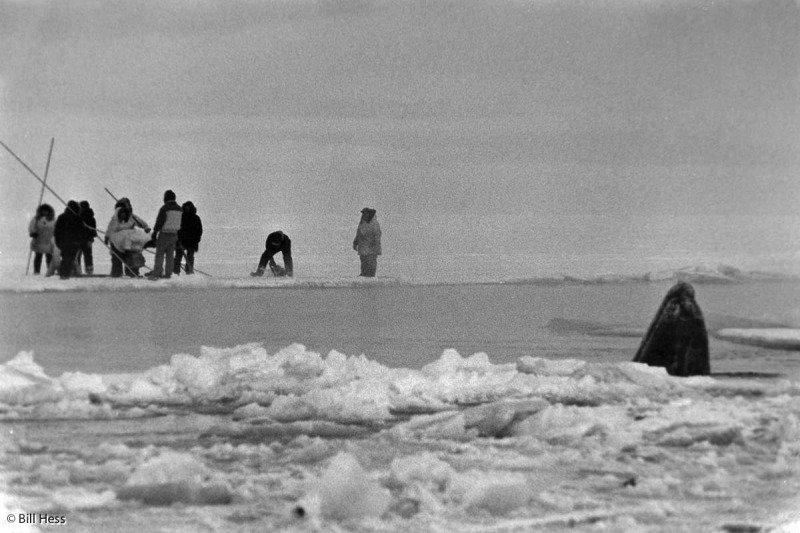
So the whalers retrieved their chainsaws, poles and other gear and set out to cut new holes. I'm certain that by now, all readers who have been following this story recognize Malik and his cap, as he now sought to ascertain the condition of the whale friends he had said goodbye to several hours before.
The light was fading. Darkness was about to set in. Before the whalers could cut more than a hole or two, Morris gave the order - everyone was to evacuate the ice, to leave the whales alone, away from the presence of the men and machines they had become accustomed to - give them a chance to work their way through the open pools still in the channels to open water.
At daybreak, Morris said, he would go on a scouting mission in the Long Ranger to see if the whales were still about, or if they had swum free into the lead - as had already been reported to the world. Until then, no one - spectator, media, or even the whalers and chainsaw cutters - was to go onto the ice anywhere in the vicinity of the rescue operation.
So I snowmachined in to Pepe's with Jeff, ordered a big, hot, steak picado meal and devoured it - and before I continue, I think I must say a word in defense of Fran Tate and Pepe's. It was widely rumored and even reported in the media that she had raised her prices by outrageous amounts - 200 percent, 300 percent and beyond - to take advantage of the media that had flocked into Barrow.
This was not true. Not only did Fran hold her prices where they had been, but before the rescue she had scheduled a special day, with discounted fare, and she honored that - for locals, media, and all. Maybe her normal prices shocked some in the media and maybe that is why they made such untrue reports and created such false rumors - but everything is expensive in Barrow.
After I gorged, I returned to my quarters hoping to finally take a halfway decent rest before rising early to develop my film and put out some prints for Jeff and UPI.
The next morning, as I worked on the prints at my NARL lab, I had this nervous feeling that I should not be doing so, but that I should be headed down to the ice - right now. I dismissed the feeling as one spawned by the fact that I had been going so relentlessly hard, day and night, for so many days straight that it now just felt wrong not to be. What could I do on the ice? - which Morris had ruled off-limits. It was still dark and no one was out there. We would not know what had become of the whales until Morris took his scouting flight.
Yet, the feeling persisted. I turned on a VHF radio that I had borrowed from NSB Wildlife and then listened as I printed to see if I might learn anything.
I was startled by what I heard. In an agitated and angry voice, Ron Morris was shouting orders to Geoff Carroll and Craig George at NSB Wildlife Management not to go onto the ice, and to keep the Eskimos off the ice. As soon as they heard Morris calling to them on the radio, Carroll jumped on his snowmachine and began the trip to the ice to find out what was happening. Craig then picked up the radio mic and responded to Morris's order. It was too late, Craig told Morris, Geoff had already left.
I kept my ear to the radio and in awhile I heard the voice of Morris, whose transmissions had now reached Carroll on the ice. Carroll had physically reached a few hunters who had defied Morris and had gone down to the ice. "I'm in charge here, I'm responsible here," an angry Morris commanded, "and I'm ordering you to get everyone and get off the ice! Get the Eskimos off the ice!"
"It's kind of out of my hands, now," Craig responded. "They've already gone to get the chainsaws."
"Get the Eskimos under control and get everyone off the ice!" Morris repeated his order.
That was it for me. I left the pictures I had been printing for UPI in the wash. I donned my gear, ran out, jumped on the snowmachine I had borrowed from Wildlife and charged off down to the ice. The sun had not yet risen, but dawn had begun to glow in the sky and to reflect off the ice.
When I arrived at the site, what you see above is what I found: Malik, speaking to a bloodied and weakened whale that now had only enough energy to barely lift its blow hole above the surface of the water. The other was equally weak - no snouts were being lifted in the way we had become accustomed to seeing. The seabird hovered above, apparently looking to see if the blood it smelled meant there was a meal to be had.
This is what I learned had happened: Geoff had arrived to find a few whalers alongside the ice breaker channel, which was now almost completely frozen over, so much so that a snowmachine could be driven over it. Alfred Brower had gone out first, to search up and down the icebreaker channels in the dark. The others joined in and had driven alongside the channel all the way to the lead without spotting a whale.
Then they turned around and as they drove back. Alfred Brower, traveling separately, I believe on the opposite side of the channel, spotted a snout, barely rising above the ice through a hole just feet across. The blowhole had come just about level to the surface of the water, but the whale could not push it above. Convinced that he was looking at dying whale, Alfred ran out onto the rubble and slush-filled, refrozen icebreaker channel, dropped to his knees and and began to chop at the rim of hole with his pocket knife until there was enough clearance for the whale to push through and breathe - rapidly for a whale, in pants.
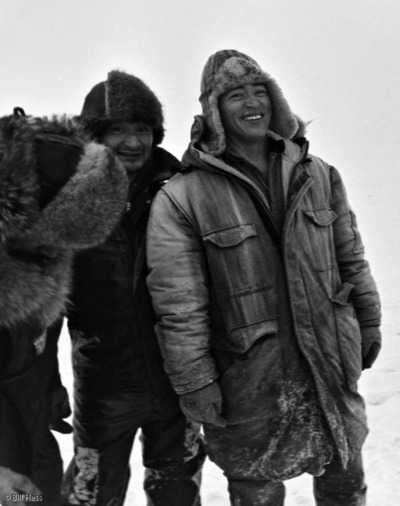 Alfred Brower, right, and his brother, Johnny, earlier in the rescue.The others quickly joined him, chopping away with their knives to save the whale. Geoff observed Crossbeak inhale some slush, because the whale could not lift its blow hole above it. The barnacles centered just behind the blow holes of the whale called Bonnet had all been ripped off. All joined Alfred in chopping with their knives until the hole was big enough to allow the whales to easily lift their blow holes above the water.
Alfred Brower, right, and his brother, Johnny, earlier in the rescue.The others quickly joined him, chopping away with their knives to save the whale. Geoff observed Crossbeak inhale some slush, because the whale could not lift its blow hole above it. The barnacles centered just behind the blow holes of the whale called Bonnet had all been ripped off. All joined Alfred in chopping with their knives until the hole was big enough to allow the whales to easily lift their blow holes above the water.
Had they not done this, all present were convinced the whales would have drowned - and soon. If this had happened, there is a good possiblity the whales would have disappeared beneath the ice. They would have vanished from sight. Morris would have taken his scouting flight, spotted no whales and would almost certainly have declared them free and gone and the rescue over. Earlier, it had been suggested that the whales be radio-tagged. This idea was rejected as potentially too stressful to the whales - but some noted that if the whales were tagged, left the area and then got stuck again somewhere else, then a whole, new, predicament would have been created.
Malik is not patting the whale's snout here. He is feeling one of its wounds - but still talking to it, still soothing it, encouraging it.
"Get the Eskimos under control and get everyone off the ice!" Morris had ordered.
Instead, the Eskimos had retrieved their chainsaws and began to cut anew. I arrived right after they had enlarged the breathing hole just enough to give the whales a little more comfort.
At the fore of this picture is one of the holes that the whales had struggled to breathe through as the icebreaker channel sealed itself over them. If this were a color photo, the darkened area would be red.
Morris said he did not want people driving their snowmachines on the ice and cutting holes with chainsaws because the whales had become accustomed to those noises, perhaps comforted by them. They might be right in the lead itself but then return from the place where they could breathe easy and free and swim as they wished to return to where they had been trapped, stuggling to breathe - just because the sound of men and engines. So said Morris.
Soon, a TV crew arrived. It would not be long before representatives of the media still in Barrow began to show up on the ice as well. Yet, they must not all have come, or they did not believe their own eyes, or maybe they just could not fully back away from their broadcasts of the day before that the whales were free.
Some now put out reports in which the whales had not actually departed to go south, but were lingering - as if by choice - in the lead or the icebreaker channels. The whales were not lingering. They were trapped, battered and beaten. I am convinced that by the time I arrived, the whales would have been dead had not Alfred Brower taken the action he had, had not the other whalers and Geoff joined in.
The whalers began to cut a new series of holes alongside the frozen, rubble-filled, channel toward the lead - which was not far away. Crew boss Johnny Leavitt stated that they would now "walk" the whales right to the lead and then watch them swim into it and depart.
Someone associated with Wildlife needed the snowmachine they had lent me, so I gave it up and was left on foot. There were plenty of machines and sleds about and I could catch a ride when it came time to leave. I like to walk, so it didn't matter.
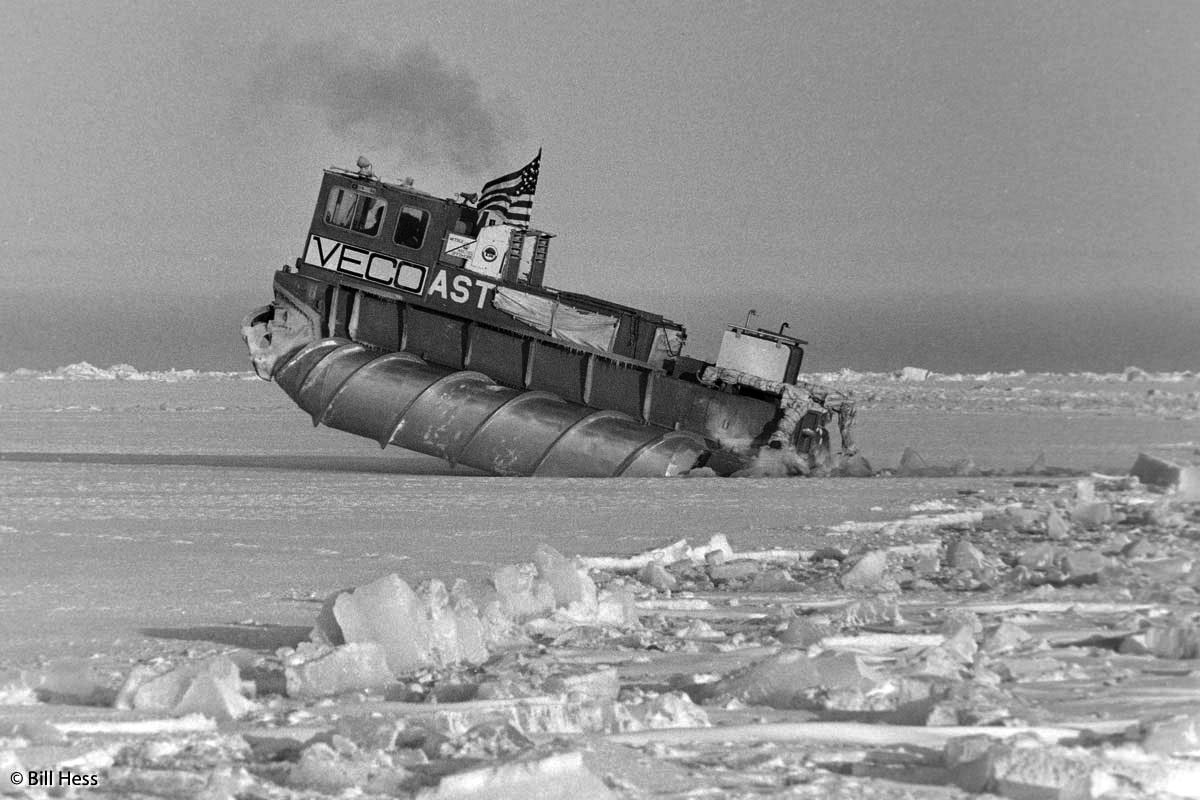
Then along came Bill Allen in the Archimedes Screw Tractor, determined to get into the action and to cut new, slush and ice-filled channels that would quickly solidify and refreeze in the -20 F weather. Remember the post I made when the C5-A jet brought the screw tractor to Barrow? Remember how I stated that I felt like I entered the Twilight Zone, from which there would be no escape?
In the foreground, is the rubble left behind in one of the icebreaker channels. I stand in the middle, on my way to make a desperate attempt to get a helicopter ride. What I really needed now was some aerial shots. I HAD to get up in a helicopter. I saw the Long Ranger land on the opposite side of the icebreaker channel, near the portable tool shed that the hunters kept mounted on a sled. Two or three journalists got out of the chopper, as did Morris, who walked over to the tool shed. My friend, Chuck Caldwell, who had accompanied me on my first student pilot cross-country flight - 850 miles from Anchorage to Barrow - was the pilot. The journalists obviously intended to stay for awhile and I knew Morris would not stay long.
I knew he would be opposed to me boarding the chopper, but, with the empty seats left behind by the journalists, he had no good argument to make, other than that he was in charge and the decision was his. I wanted a seat, I wanted to get my aerial photos, so I decided I would make the request and if he denied me, I would point out the obvious and see if I could reach a reasonable segment of his mind.
I scurried across the rubble-filled channel as quickly as I dared, but when I got to the side where the helicopter was, I found a completely open channel about three feet wide, separating the rubble ice in the channel from the main ice.
I took a flying leap towards what I was certain was solid ice. I was wrong. My feet went through snow with nothing but water below. The ice must have broken away from beneath it and left it hanging, or maybe it was drift from the wind. As I plunged quickly down almost to my waist, I threw my weight and cameras forward and spread my arms to stop me from going down further. I felt the shock of 29 degree water strike the flesh of my legs; I felt my bunny boots filling up, and - forgive me for being crude but true - got that horrible shock a guy gets when his balls hit frigid water and instantly shrivel and shrink away to almost nothing.
I had already made all the babies I ever would, so in some ways it probably wouldn't have really mattered if they had been rendered inoperable, but I still wanted to enjoy life to the maximum amount possible.
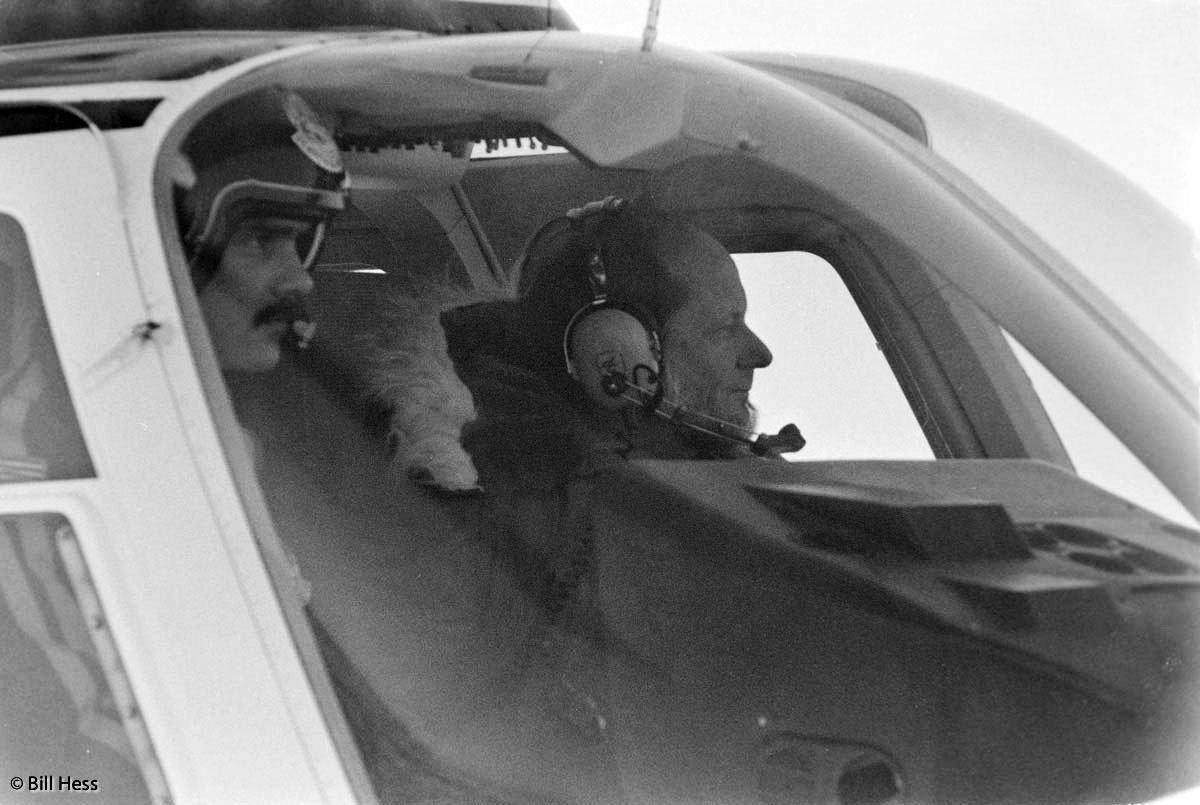
My colleague, Charles Mason, who could not get his bosses at the Fairbanks Daily News-Miner to buy him a plane ticket to Barrow and so had made a deal with a top photo agency to shoot for them, came running to my side. "Are you okay?" he asked. I believe he was among those who had just gotten off the Long Ranger. I was. I looked up, straight into the glinting eyes of Ron Morris, who had returned to the helicopter and was about to reboard. I had enough of my weight on the ice that I was able to pull myself out of the water on my own.
Good! The temperature was somewhere close to -20 F. Now that I was wet almost from the waist down, Morris could not deny me a seat on the helicopter. As I returned to my feet, he climbed back into the idling helicopter. I started to run over - then, to my disbelief, Chuck applied power and the helicopter began to rise. Morris was taking off without me. I raised my camera and shot this picture and I shot in anger.
I must stress I was not angry at Chuck. I am certain he wanted to take me. Chuck had not seen me go into the water. I am fully confident that if he had, he would have exercised his ultimate authority as pilot-in-command and would have overruled Morris and made certain I got onto the chopper. I have no doubt.
After the rescue, as I was putting Uiñiq together, I called Morris for an interview. Late in the interview, I brought up the incident and asked him why he left me behind after I had fallen into the water. He grew angry. He vehmently denied ever knowing that I had gone into the water. If he had seen me go into the water, he said, he would surely have invited me onto the heliopter.
Yet, I had seen his eyes, connected sharply with mine, looking directly into mine, even as my legs were still in the water. One does not forget something like that. In his defense, I must acknowledge that he was in a tremendously difficult spot. The entire world, including President Ronald Reagan and wife Nancy, were closely watching from a distance. If the rescue obviously failed, a finger of blame - perhaps even the Presidential finger - would undoubtedly swing itself to point straight at Ron Morris. So I suppose it is possible he could have been under such great stress that his eyes could stare right into mine as I was paritially in the water, but could see only backwards, into whatever frightful turmoil roiled in his own mind.
As the relationship between the Alaska Eskimo Whaling Commission, the North Slope Borough and NOAA was critically important, vital even, to the bowhead hunt, I did not write the incident up in Uiñiq. I did write it into my original draft of the gray whale chapter in Gift of the Whale, but the chapter was way too long for the available space, so I cut the incident as I pared the chapter down.
Morris is retired. I am told he is living in California now. I hope he is warm and that life in what can be a hard age is good for him. Twenty-three-and-a-half years have passed. Yet, I am telling my story here and this is part of it.
I was worried, and not certain what to do, but very soon, as I kept myself moving, the water between my feet and the inner layer of my rubberized, insulated to 60 below bunny boots began to warm. I also discovered that, as long as I kept moving, even wet, my insulated Arctic pants still insulated. They did not make my legs warm, but did not leave them unbearably cold, either.
As it was obvious I was not going to get on a helicopter, I walked back to where the whale hunters were at work, rescuing whales, where they cut and opened breathing holes with chainsaws and poles - just as they had been doing every day for nearly two weeks now.
And now, another irony was about to fall upon me. Readers who have been with this series from the beginning will recall that, at the start of my career, there were two national publications I had wanted above all others to publish in - National Geographic and Life Magazine. I made it into National Geographic early in my career, but Life had eluded me. After the rescue began, Life was among a large group of publications and agencies, including Newsweek and Sipa, where staff had seen my first wire-service images of the whales and rescue, and had tried to hire me to shoot color for them. I had turned them all down, including Life, because I put my magazine, Uiñiq, first and it was all black and white and I wanted to shoot black and white.
I had gotten Life to agree to consider my black and whites if I could send them a good selection by Thursday, ten days in the future. I had hoped the rescue would be over in time for me to do that. But this was that Thursday. The ten days had passed. I had had no time to do an edit-and-print session for Life. The edits I did for UPI were quick and partial. I didn't even develop all my film. The prints I made were quick and dirty - good enough for the wires, but not to submit to Life.
As I walked back, I saw a whale rise high through one of the new holes the whalers had cut in the ice this day, with an icebreaker cruising behind. This was good, because it meant the whales were recovering from the shocked and lethargic state they had been in when I first arrived.
I wanted to photograph what I had just seen. To do so, I would have to stay at a distance and use a telephoto lens. If I were to go closer to the hole and use a wider lens, the icebreakers would recede into tiny things at the back of the frame. A telephoto would hold them prominent in the frame. I positioned myself on a mound of ice, framed the scene just like I wanted it, and then waited for a whale to rise. It was a fairly long wait, as there were several new holes and the whales were going back and forth between them. As I waited, Charles Mason walked by. He was aglow, ebullient, his spirits high, his mood good. This was a stark contrast from how he had been earlier in the rescue.
He had exercised bold initiative to get to Barrow, but once here, had been overwhelmed by the environment and had sunk into depression. We had eaten at Pepe's together a few times and he had lamented that he had come, he had wondered if he was a true photojournalist at all, and had pointed to one of our colleagues from Alaska who had worked in the papers but had then gone overseas into war zones and had made an international name for himself.
This man, Mason said, was a true photojournalist. He had what it took. He was not so sure about himself. He was almost ready to go home. I knew how he felt, because I have felt that way many times - and I will feel that way again in the future. So I encouraged him to hang on and see it through. Early on, he missed a ride on a helicopter and so I told him to jump on the back of my snowmachine and I would take him to the whales. He was afraid. The wind would be too hard on him, he said. I told him to get on, it would be okay, he would enjoy the ride.
He did, and he did enjoy the ride. He did not go home. He stayed put, he shot, he worked hard.
"I hope I don't get in the way of your shot," he now called out cheerfully as he walked past me. Good, this meant he was aware of what I was doing and would respect it. He would not ruin my picture. I waited a bit longer. Soon, a whale rose just where I wanted it - and just as I was about to snap the shutter, Charles charged in between me and the whale with a wider lens. He blocked my shot.
I repositioned myself a bit and set it up again. I waited. Then... same thing again! Charles charged in and blocked my shot a second time. I reestablished the shot. Again, at the critical moment Charles charged in and blocked it. Three times in a row. I then decided that what he had really meant was, "I'm going to get in the way of your shot." I was angry. I walked up to him, to his left side and slightly behind, stopped and waited. The whale rose. He lifted his camera. Before he could press the shutter, I shoved him - hard.
"Geez, Bill!" he stammered, shocked. As I say, we had become friends.
"What the hell you doing?" I countered. "You knew I had been waiting for that shot a long time, and still you screwed it up!" He apologized profusely, told me I had every right to do what I had just done. Suddenly, I felt awful, horrified at myself. I was on the Arctic ice, with Iñupiat whalers, who had taught me about the necessity of good will on the ice, and I had just lost my temper and done something awful. I felt ashamed of myself.
Now I apologized. Through the entire encounter, he continued to glow. He then told me his agency had been pushing his photos at Life. Life liked them. They were going to use his pictures for their spread on the gray whale rescue. They did, and there were some excellent images, all in bright and sparkling color. Afterward, Life would enter the Charles Mason gray whale rescue essay in many contests, including the World Press competion, where he would win the exceedlingly prestigious Oskar Barnack Award.
It did wonders for his career. Overnight, he became a bit of a celebrity in the worlds of photojournalism and art photography. The Univerisity of Alaska hired him as head photography instructor and gave him a great deal of freedom and support to go out and shoot his own projects - at which he did very well.
"Sometimes," he told me as the hunters cut, the whales continued to rise and the icebreakers appeared to drift just beyond the shore ice, "Something wild and crazy happens, you just hang on and go for the ride, and it works out amazing.”
I could not help but admire his talent and what he had done, but it was also a very funny feeling for me, given the course of this rescue. You could say I had no one to blame but myself, for turning down Life's original offer because I felt even more strongly towards Uiñiq magazine, which had a circulation of less than 3000 people, compared to Life's millions.
I had never been inclined to enter photo competitions, but for 1988, I made an exception. I knew that every photojournalist who had come to the rescue would almost certainly enter the National Press Photographer's Association - Pictures of the Year Awards. I did not want them to leave me in the cold, so I entered. I had little consciousness of the World Press Awards and none at all of the very prestigious Oskar Barnack Award, so I did not enter there.
Life also entered Charles' essay at NPPA-POY. Only one gray whale rescue won an award at NPPA and it was featured on the back cover of the Pictures of the Year coffee table book for 1988 - my picture of Malik reaching out to say to goodbye to Crossbeak - the one that I used to close the series of Malik's first goodbye.
Even so, it was just one picture of many of a miltitude of events from around the world that won NPPA-POY awards that year, whereas the Oskar Barnak Award was a unique thing. Few took much note of my NPPA award, that I had won over the same photos that won the Oskar Barnack Award, but the entire world of photojournalism took big note of the work and photographer that had won the latter. Both Charles and I were later invited a short time later to be panelists at a UAF seminar on cold weather photography. He was introduced as the winner of the prestigious Oskar Barnack Award for his work on the gray whale rescue. He got loud and enthusiastic applause. My work on the gray whale rescue was not mentioned, nor was my NPPA-POY award.
I was introduced as "an enthnographic photographer" - a term I do not relate to - who published Uiñiq magazine on behalf of the North Slope Borough. I think only one person in the audience knew Uiñiq - Dr. James Nageak, Iñupiaq language professor from Barrow. To the audience, Charles was the photographic star of the rescue. They did not know that I had even been there at all.
I couldn't mention it, either. In fact, I feel guilty mentioning it now, because it runs counter to Iñupiat teachings to boast about what you have done. But it is part of my story, the story I tell here, and if I don't write it, no one will ever know it. Perhaps it is petty of me, but I have just enough of an ego that I want people to know. The audience didn't know it, but I was there - from beginning to end. I didn't manage to photograph everything I wanted to, but I still covered the rescue to a depth, breadth and quality matched by no other photographer.
And now there is a major motion picture and the starring character is a composite of Oran Caudle Caudell and me - but mostly me - Oran at the beginning, when he sent his tape to NBC affiliate Channel 2. The rest of the time, the role filled by the main character, including the exclusives he got, was in real life filled. In my own adventure, a moment came in which one of the greatest and most successful Iñupiat whale harpooners of modern times was alone with the whales, walking with the whales, gently talking to the whales, patting the whales, loving the whales. It was a moment the likes of which had never happened before. I doubt it will ever happen again. I was there for it, alone with Malik, the harpooner, and the whales.
And when it was all over, I had a beautiful, black-haired Apache wife, Margie, who loved me, to go home to, to fall exhausted into her arms. Adam Carlson only had Drew Barrymore. And on the movie set, my book, Gift of the Whale, was everywhere, used as "the Bible" for this set and that, and for this wardrobe and that wardrobe and no one knows it was so, save for the tiny handful of people who read this blog, because neither my book nor I were ever credited.
I feel petty and self serving in stating all this, but it is fact. And I experienced something so unique and have just enough ego that I want people who see this in many ways wonderful and fun, fictitious, uplifting movie to know.
This does not take anything away from Charles. He is a superb photographer. He entered the contest, I didn't. He earned his award. He deserves the recognition and success it helped him to achieve. The fact is, if I could go 23 years back in time, foresee what I now know and be put in the same position, I would do the same thing all over again. Charles would still score in Life. I would still make Uiñiq magazine. His fine gray whale rescue work would still be viewed by millions upon millions, mine by a few thousand.
His day arrived, mine didn't. I felt kind of like the Kevin Costner character at the conclusion of the baseball movie, Bull Durham. My day has not yet come, except in periods of minutes here and there, but I still believe it will. I just hope it gets here before I die - not so I can relax, but so I can hopefully gain more support to do the work I still need to do. I've got lots of work yet to do. I have a huge number of stories to tell - more than I can possibly tell, but I would like to tell as many of them as I can.
But then, really, what does it matter if my day ever really comes? I have so far had a wonderful career. I have known freedom that few other photographers ever do. I have never come close to doing all that I have imagined that I would - but I have still done many things - more than most people who have lived and died ever got a chance to do. I have had the opportunity to work with great and unique people.
I am a most fortunate man. So stop complaining, Bill Hess! Stop whining. Get on with it! Do whatever you still can, however you can do. Just don't stop. Until you die. Then you can stop. Just leave something behind that will continue to reach people who later die, just like you did.
After my conversation with Charles ended, I shot this picture, similar to the ones he had blocked - except not quite so compressed, because I never did back up as far away from the action to where I had originally set up the shot.
As evening approached, the whalers had cut holes to within a few hundred yards of the open lead - perhaps 400 yards. Not close enough for the whales to make their leap, but close enough to raise the spirits of the crew. Before darkness would set in, Johnny Leavitt planned to have his crew cut one last hole, a large one for the whales to overnight in. Then, in the morning, the whalers could "walk" the whales to the lead. Everyone could watch, photograph, shout and cheer as the whales swam free - perhaps to raise their flukes into the air and slap the water with a splash, for the first time since they had become trapped three weeks earlier.
Then a very strange thing happened. The icebreakers readied themselves to come and cut again. Morris gave the order for everyone to evacuate the ice. The Soviets were going to come in to make another cut, one that would set the whales free - no more need for chainsaws.
Johnny, Malik the whalers and the Wildlife biologists were upset. They had a chance to "walk" the whales to freedom, to know for certain that they made it there safely. The icebreakers would not finish their work until well after dark. Perhaps no one would even see the whales after dark. Perhaps no one would ever know.
Mayor Ahmaogak, his wife Maggie, some of his top staff and North Slope Borough Public Information Officer Marie Carroll were about to fly in the Big Bird to the icebreakers, to give advice on where they should cut. This was a Borough delegation and no one outside the Borough, not even Morris, could prevent me from going, so the Big Bird flew by and picked me up. I had hoped we would fly over the holes, so I could finally get a few aerial shots, but we didn't. As the sky dimmed, darkness approached, and the Iñupiats on the ice who knew what they were doing evacuated at Morris's order and the advance of the icebreakers, I was again on the Makarov, the Arseniev close by, taking new cuts at the ice.
Onboard the Makarov, Mayor George Ahmaogak and Marie Adams went over navigation charts with Soviet officers to better direct them on where best to make their final cuts toward the still-trapped whales.
Again, Morris had ordered everyone to stay off the ice until he did his survey the next morning and gave the goahead for people to return. Now, almost all the media had left. Again, Alfred Brower defied the order of Morris and was out on the ice, early, well before sunrise. He reported that about 8:30 AM, he saw a whale in a hole in what was once again rapidly refreezing slush and rubble. The whale then left that hole, went backwards toward another hole, where the other whale was. Both then left that hole and appeared to be headed in the right direction, toward the lead, which was close.
Still before daybreak, I walked to Wildlife and then headed out with Craig and George, this time on a sled. Soon, we found several members of the chainsaw crew and then went exploring along the new icebreaker cuts with them. As before, the channels were filled mostly with chunks of ice in slush. As if it were nothing at all, the whalers picked their way across these channels by stepping on the larger chunks of ice, anchored only in slush and very thin, less than an inch. I wanted to follow but was hesitant.
"Step on just the chunks, and you'll be okay," Malik told me. "Step on that thin stuff, you'll fall through. Just remember to walk like a polar bear."
So I did. We found a few "whale tracks" - places where one or both of the whales had surfaced in the slush and chunks before it fully refroze. The tracks were pocked with specks and small balls of frozen blood. Finally, we came to the last track and this is it. It appeared to be within reasonable swimming distance of the lead. I shot several frames but the temperature about -25 F and some of the salt water must have made it into my cameras after all, because the other frames I shot here all overlap each other, due to shutter-lag caused by the cold.
The whalers were happy, yet frustrated. No one knew for certain whether the whales had swum into the lead and resumed their migration south and they knew that they would have known if they had just been allowed to follow their own plan. Also, given all the blood, it was apparent that the whales had struggled and battered themselves all over again. They still had over 300 miles to reach waters not hemmed in by ice. The whalers and NSB biologists believed that if they had made it into the lead, as it appeared they did, they had now resumed their journey in a more weakend condition than they would have been had they been "walked" to the lead.
It wasn't long before a British TV camera crew showed up and then one other. Media wise, that was just about it for this, the final segment of the rescue. Here, they tape Freddie Joe Kaleak as he digs chunks of frozen whale blood out of an ice fracture.
Freddie Joe Kaleak holds chunks of frozen whale blood.
Then the Long Ranger landed nearby. Ron Morris got out. Citing the authority he said he held under the Marine Mammal Protection Act, he ordered everyone off the ice. He said that if the whales were out swimming free in the lead, where they could splash with their flukes, breathe freely, follow their natural instincts, resume their journey south and do any damn thing they wanted, he did not want them to hear our machines and come swimming back to us under the ice, where they could not breathe.
There was nothing more to be done anyway, so, as Morris returned to the chopper and flew off to look for the whales that he would never spot; we left, but we took our time. We stopped at whale holes along the way - all of them refrozen over. At one, where the ice looked to be not much more than one inch thick, I was surprised to see Johnny Brower jump in and start to Eskimo dance. That is another of the many photos that I have misplaced. It is somewhere, though, and someday I must find it.
Seeing that Johnny did not fall through, I jumped on and started to Eskimo dance with him. It felt like I was dancing on a water bed. Then Craig George stomped on the ice behind me and put a hole in it. I got off. Johnny wasn't done. "This is how a polar bear crosses thin ice," he said. Then, acting like he was a polar bear himself, he scurried back and forth on his belly on the thin ice.
Then, as we continued back towards land, Freddie Joe Kaleak did a sit-down Eskimo dance on the traveling sled. Johnny Brower and Billy Adams smiled.
The Great Gray Whale Rescue of October, 1988, had come to its end.
But this series is not over. I have one post left to put up - an epilogue. It will be worth it to come back.
*I didn't fully succeed at this goal.
p>
Complete series index:
Part 2: Roy finds the whales; Malik
Part 5: To rescue or euthanize
Part 6: Governor Cowper, ice punch, chainsaw holes
Part 7: Malik provides caribou for dinner
Part 8: CNN learns home is sacred place
Part 9: World's largest jet; Screw Tractor
Part 11: Portrait: Billy Adams and Malik
Part 12: Onboard Soviet icebreakers


